Gap Analysis of CSL
VerifiedAdded on 2023/01/03
|28
|5603
|33
AI Summary
This report delves into the ESC (environmental, strategic, and capability) gap faced by multinational companies operating in the global market. The analysis focuses on Commonwealth Serum Laboratories Limited (CSL Limited) based in Melbourne, Australia. The report analyzes the business environment of CSL Limited, identifies the factors responsible for the gaps, and provides recommendations to counteract or reduce them. The report uses tools such as Porter's five forces model, graphs, and balance score to support the analysis.
Contribute Materials
Your contribution can guide someone’s learning journey. Share your
documents today.
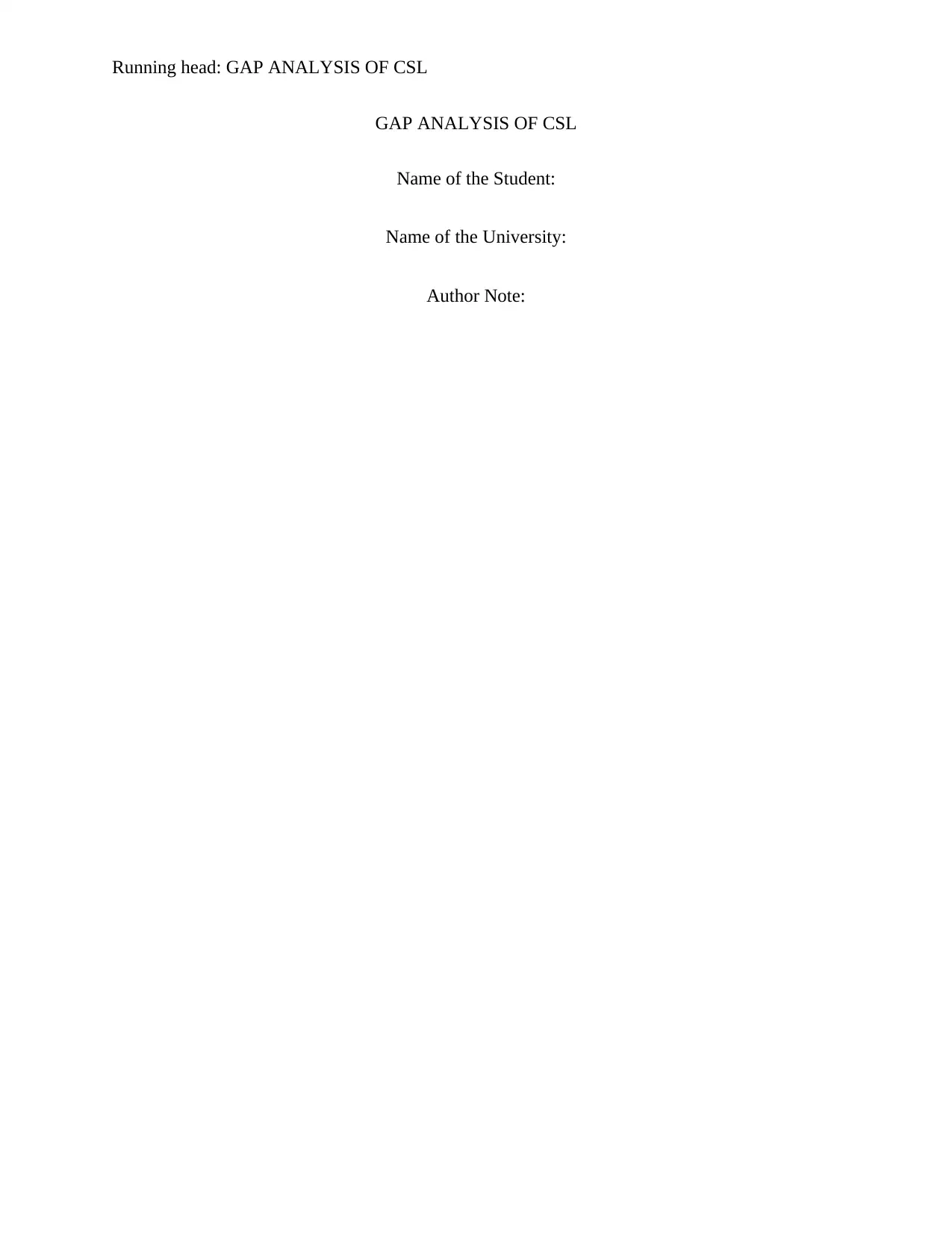
Running head: GAP ANALYSIS OF CSL
GAP ANALYSIS OF CSL
Name of the Student:
Name of the University:
Author Note:
GAP ANALYSIS OF CSL
Name of the Student:
Name of the University:
Author Note:
Secure Best Marks with AI Grader
Need help grading? Try our AI Grader for instant feedback on your assignments.
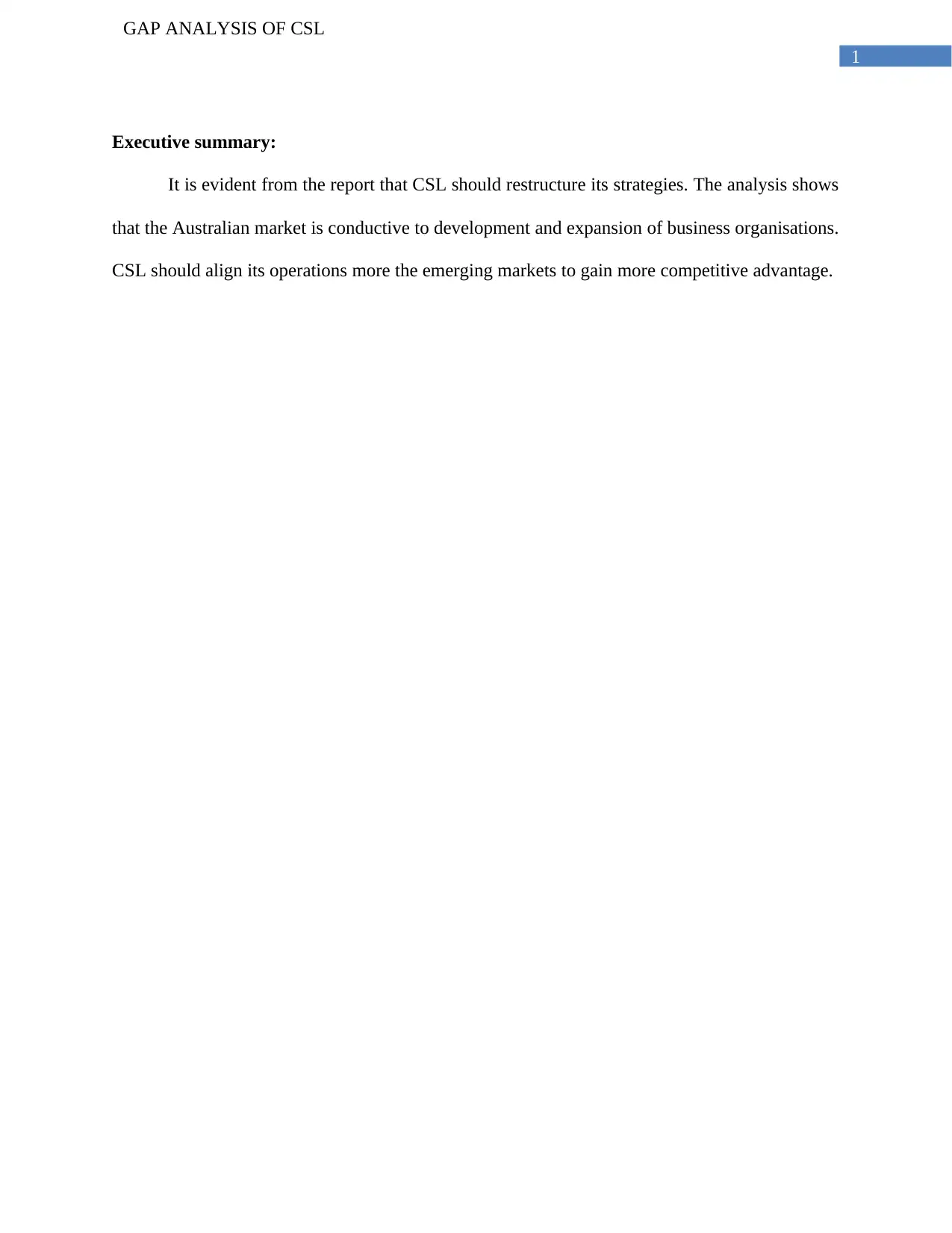
1
GAP ANALYSIS OF CSL
Executive summary:
It is evident from the report that CSL should restructure its strategies. The analysis shows
that the Australian market is conductive to development and expansion of business organisations.
CSL should align its operations more the emerging markets to gain more competitive advantage.
GAP ANALYSIS OF CSL
Executive summary:
It is evident from the report that CSL should restructure its strategies. The analysis shows
that the Australian market is conductive to development and expansion of business organisations.
CSL should align its operations more the emerging markets to gain more competitive advantage.
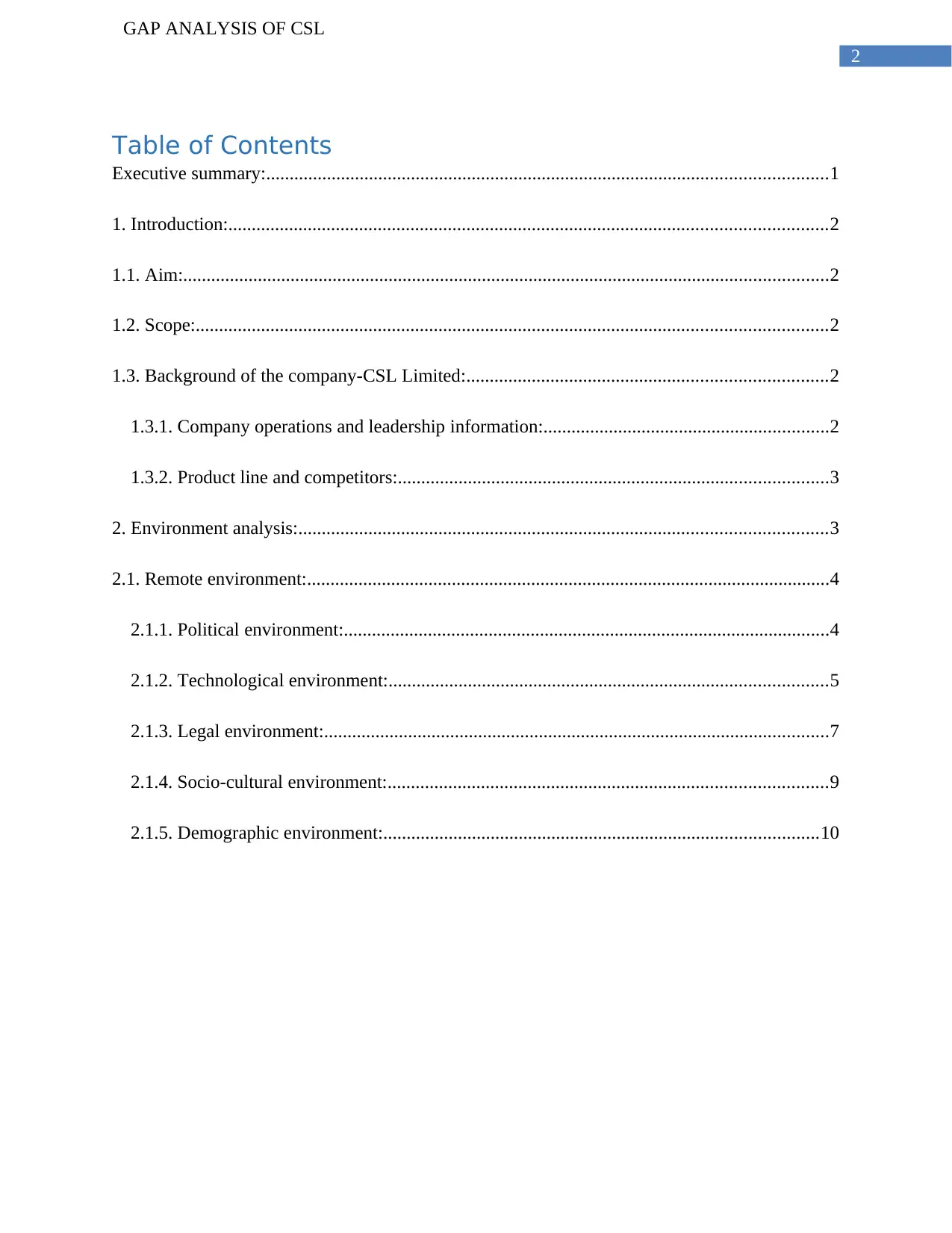
2
GAP ANALYSIS OF CSL
Table of Contents
Executive summary:........................................................................................................................1
1. Introduction:................................................................................................................................2
1.1. Aim:..........................................................................................................................................2
1.2. Scope:.......................................................................................................................................2
1.3. Background of the company-CSL Limited:.............................................................................2
1.3.1. Company operations and leadership information:.............................................................2
1.3.2. Product line and competitors:............................................................................................3
2. Environment analysis:.................................................................................................................3
2.1. Remote environment:................................................................................................................4
2.1.1. Political environment:........................................................................................................4
2.1.2. Technological environment:..............................................................................................5
2.1.3. Legal environment:............................................................................................................7
2.1.4. Socio-cultural environment:..............................................................................................9
2.1.5. Demographic environment:.............................................................................................10
GAP ANALYSIS OF CSL
Table of Contents
Executive summary:........................................................................................................................1
1. Introduction:................................................................................................................................2
1.1. Aim:..........................................................................................................................................2
1.2. Scope:.......................................................................................................................................2
1.3. Background of the company-CSL Limited:.............................................................................2
1.3.1. Company operations and leadership information:.............................................................2
1.3.2. Product line and competitors:............................................................................................3
2. Environment analysis:.................................................................................................................3
2.1. Remote environment:................................................................................................................4
2.1.1. Political environment:........................................................................................................4
2.1.2. Technological environment:..............................................................................................5
2.1.3. Legal environment:............................................................................................................7
2.1.4. Socio-cultural environment:..............................................................................................9
2.1.5. Demographic environment:.............................................................................................10
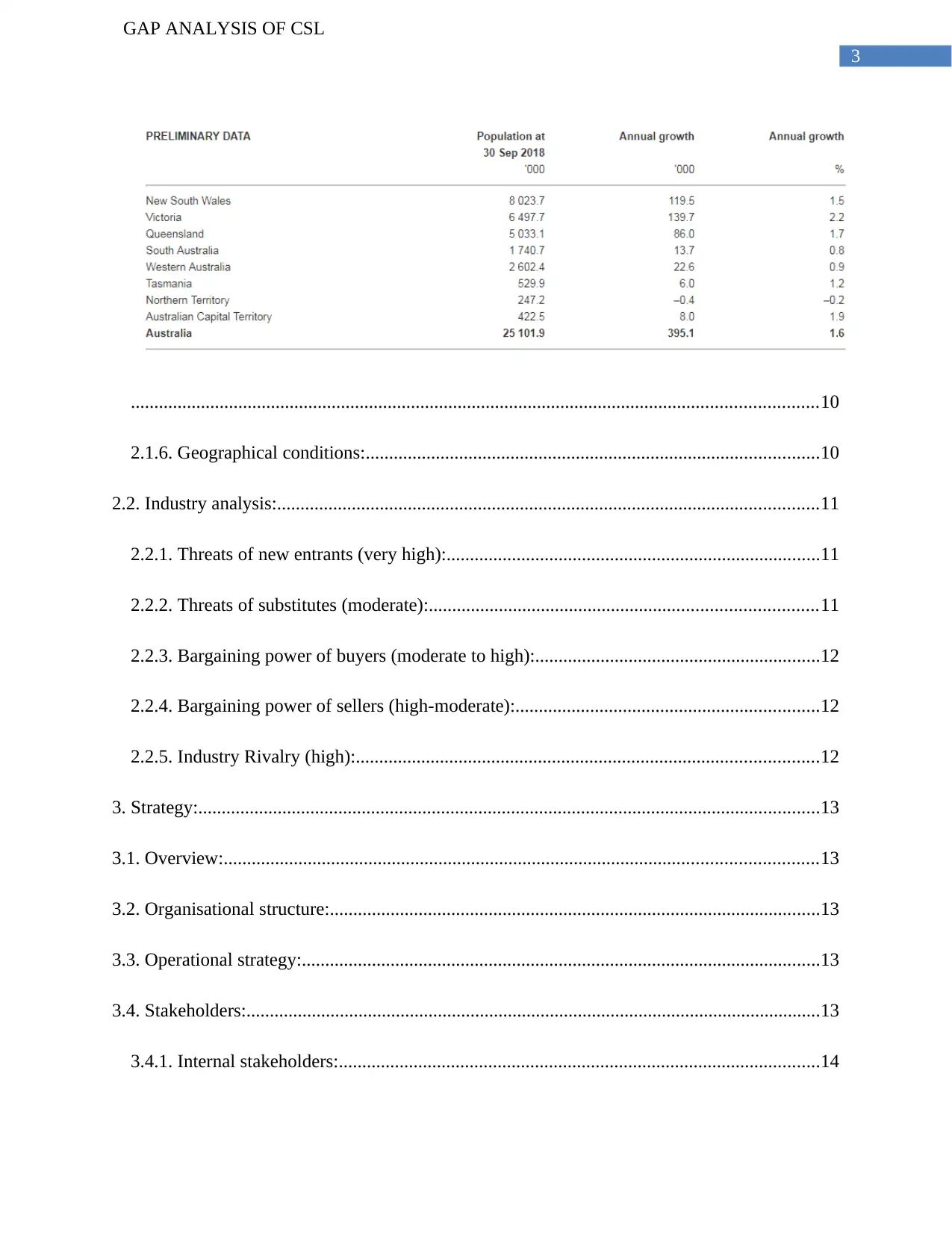
3
GAP ANALYSIS OF CSL
...................................................................................................................................................10
2.1.6. Geographical conditions:.................................................................................................10
2.2. Industry analysis:....................................................................................................................11
2.2.1. Threats of new entrants (very high):................................................................................11
2.2.2. Threats of substitutes (moderate):...................................................................................11
2.2.3. Bargaining power of buyers (moderate to high):.............................................................12
2.2.4. Bargaining power of sellers (high-moderate):.................................................................12
2.2.5. Industry Rivalry (high):...................................................................................................12
3. Strategy:.....................................................................................................................................13
3.1. Overview:...............................................................................................................................13
3.2. Organisational structure:.........................................................................................................13
3.3. Operational strategy:...............................................................................................................13
3.4. Stakeholders:...........................................................................................................................13
3.4.1. Internal stakeholders:.......................................................................................................14
GAP ANALYSIS OF CSL
...................................................................................................................................................10
2.1.6. Geographical conditions:.................................................................................................10
2.2. Industry analysis:....................................................................................................................11
2.2.1. Threats of new entrants (very high):................................................................................11
2.2.2. Threats of substitutes (moderate):...................................................................................11
2.2.3. Bargaining power of buyers (moderate to high):.............................................................12
2.2.4. Bargaining power of sellers (high-moderate):.................................................................12
2.2.5. Industry Rivalry (high):...................................................................................................12
3. Strategy:.....................................................................................................................................13
3.1. Overview:...............................................................................................................................13
3.2. Organisational structure:.........................................................................................................13
3.3. Operational strategy:...............................................................................................................13
3.4. Stakeholders:...........................................................................................................................13
3.4.1. Internal stakeholders:.......................................................................................................14
Secure Best Marks with AI Grader
Need help grading? Try our AI Grader for instant feedback on your assignments.
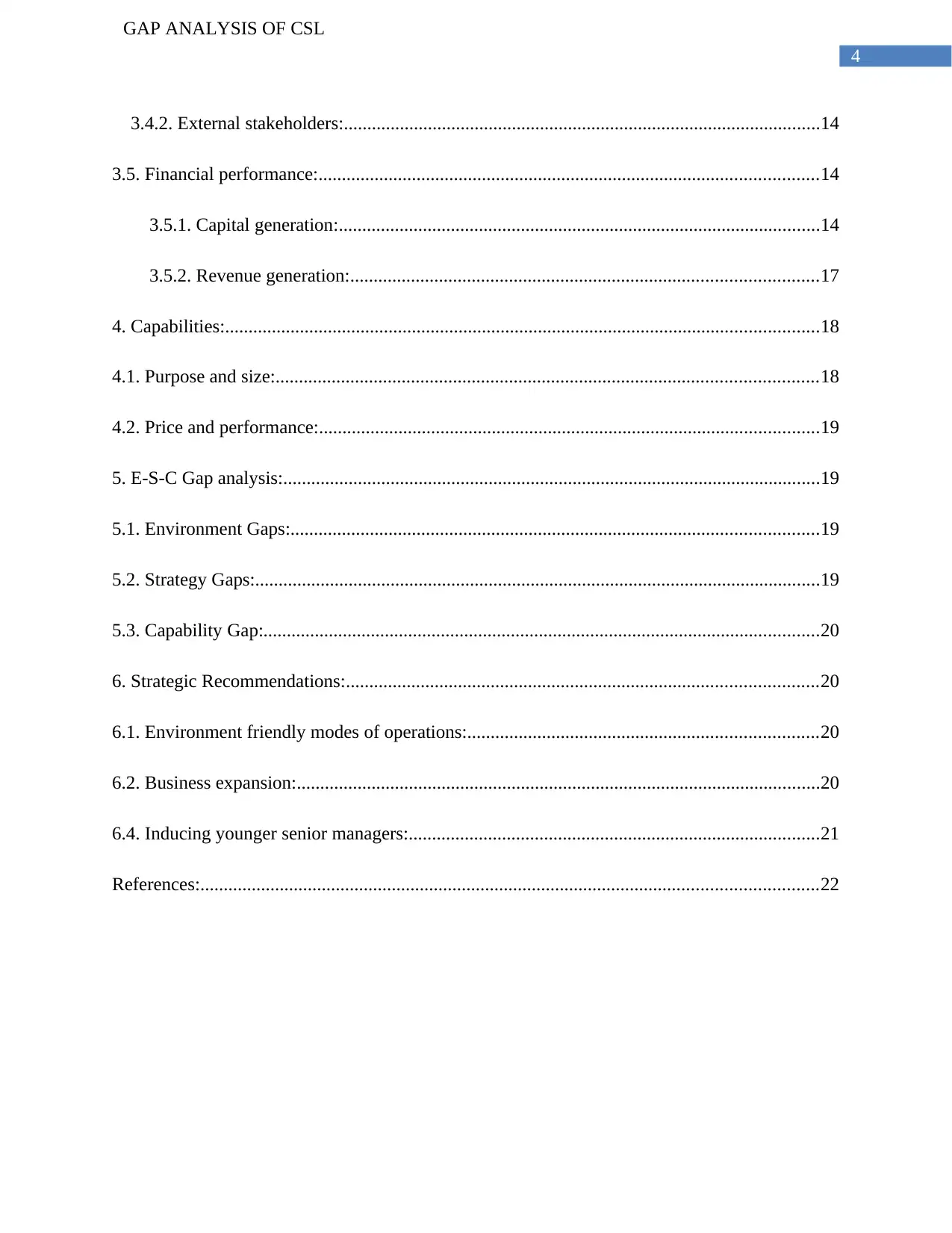
4
GAP ANALYSIS OF CSL
3.4.2. External stakeholders:......................................................................................................14
3.5. Financial performance:...........................................................................................................14
3.5.1. Capital generation:.......................................................................................................14
3.5.2. Revenue generation:....................................................................................................17
4. Capabilities:...............................................................................................................................18
4.1. Purpose and size:....................................................................................................................18
4.2. Price and performance:...........................................................................................................19
5. E-S-C Gap analysis:...................................................................................................................19
5.1. Environment Gaps:.................................................................................................................19
5.2. Strategy Gaps:.........................................................................................................................19
5.3. Capability Gap:.......................................................................................................................20
6. Strategic Recommendations:.....................................................................................................20
6.1. Environment friendly modes of operations:...........................................................................20
6.2. Business expansion:................................................................................................................20
6.4. Inducing younger senior managers:........................................................................................21
References:....................................................................................................................................22
GAP ANALYSIS OF CSL
3.4.2. External stakeholders:......................................................................................................14
3.5. Financial performance:...........................................................................................................14
3.5.1. Capital generation:.......................................................................................................14
3.5.2. Revenue generation:....................................................................................................17
4. Capabilities:...............................................................................................................................18
4.1. Purpose and size:....................................................................................................................18
4.2. Price and performance:...........................................................................................................19
5. E-S-C Gap analysis:...................................................................................................................19
5.1. Environment Gaps:.................................................................................................................19
5.2. Strategy Gaps:.........................................................................................................................19
5.3. Capability Gap:.......................................................................................................................20
6. Strategic Recommendations:.....................................................................................................20
6.1. Environment friendly modes of operations:...........................................................................20
6.2. Business expansion:................................................................................................................20
6.4. Inducing younger senior managers:........................................................................................21
References:....................................................................................................................................22
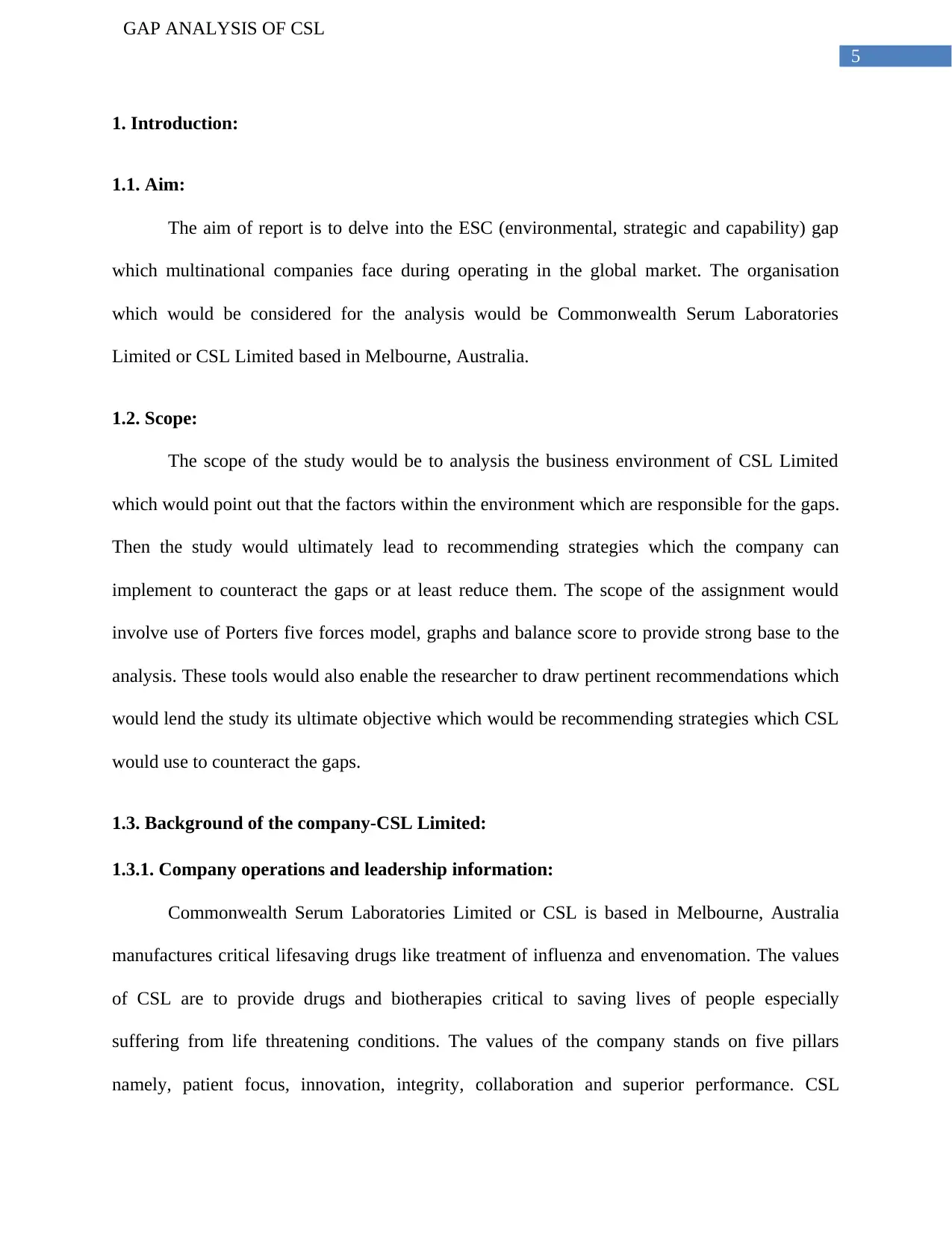
5
GAP ANALYSIS OF CSL
1. Introduction:
1.1. Aim:
The aim of report is to delve into the ESC (environmental, strategic and capability) gap
which multinational companies face during operating in the global market. The organisation
which would be considered for the analysis would be Commonwealth Serum Laboratories
Limited or CSL Limited based in Melbourne, Australia.
1.2. Scope:
The scope of the study would be to analysis the business environment of CSL Limited
which would point out that the factors within the environment which are responsible for the gaps.
Then the study would ultimately lead to recommending strategies which the company can
implement to counteract the gaps or at least reduce them. The scope of the assignment would
involve use of Porters five forces model, graphs and balance score to provide strong base to the
analysis. These tools would also enable the researcher to draw pertinent recommendations which
would lend the study its ultimate objective which would be recommending strategies which CSL
would use to counteract the gaps.
1.3. Background of the company-CSL Limited:
1.3.1. Company operations and leadership information:
Commonwealth Serum Laboratories Limited or CSL is based in Melbourne, Australia
manufactures critical lifesaving drugs like treatment of influenza and envenomation. The values
of CSL are to provide drugs and biotherapies critical to saving lives of people especially
suffering from life threatening conditions. The values of the company stands on five pillars
namely, patient focus, innovation, integrity, collaboration and superior performance. CSL
GAP ANALYSIS OF CSL
1. Introduction:
1.1. Aim:
The aim of report is to delve into the ESC (environmental, strategic and capability) gap
which multinational companies face during operating in the global market. The organisation
which would be considered for the analysis would be Commonwealth Serum Laboratories
Limited or CSL Limited based in Melbourne, Australia.
1.2. Scope:
The scope of the study would be to analysis the business environment of CSL Limited
which would point out that the factors within the environment which are responsible for the gaps.
Then the study would ultimately lead to recommending strategies which the company can
implement to counteract the gaps or at least reduce them. The scope of the assignment would
involve use of Porters five forces model, graphs and balance score to provide strong base to the
analysis. These tools would also enable the researcher to draw pertinent recommendations which
would lend the study its ultimate objective which would be recommending strategies which CSL
would use to counteract the gaps.
1.3. Background of the company-CSL Limited:
1.3.1. Company operations and leadership information:
Commonwealth Serum Laboratories Limited or CSL is based in Melbourne, Australia
manufactures critical lifesaving drugs like treatment of influenza and envenomation. The values
of CSL are to provide drugs and biotherapies critical to saving lives of people especially
suffering from life threatening conditions. The values of the company stands on five pillars
namely, patient focus, innovation, integrity, collaboration and superior performance. CSL
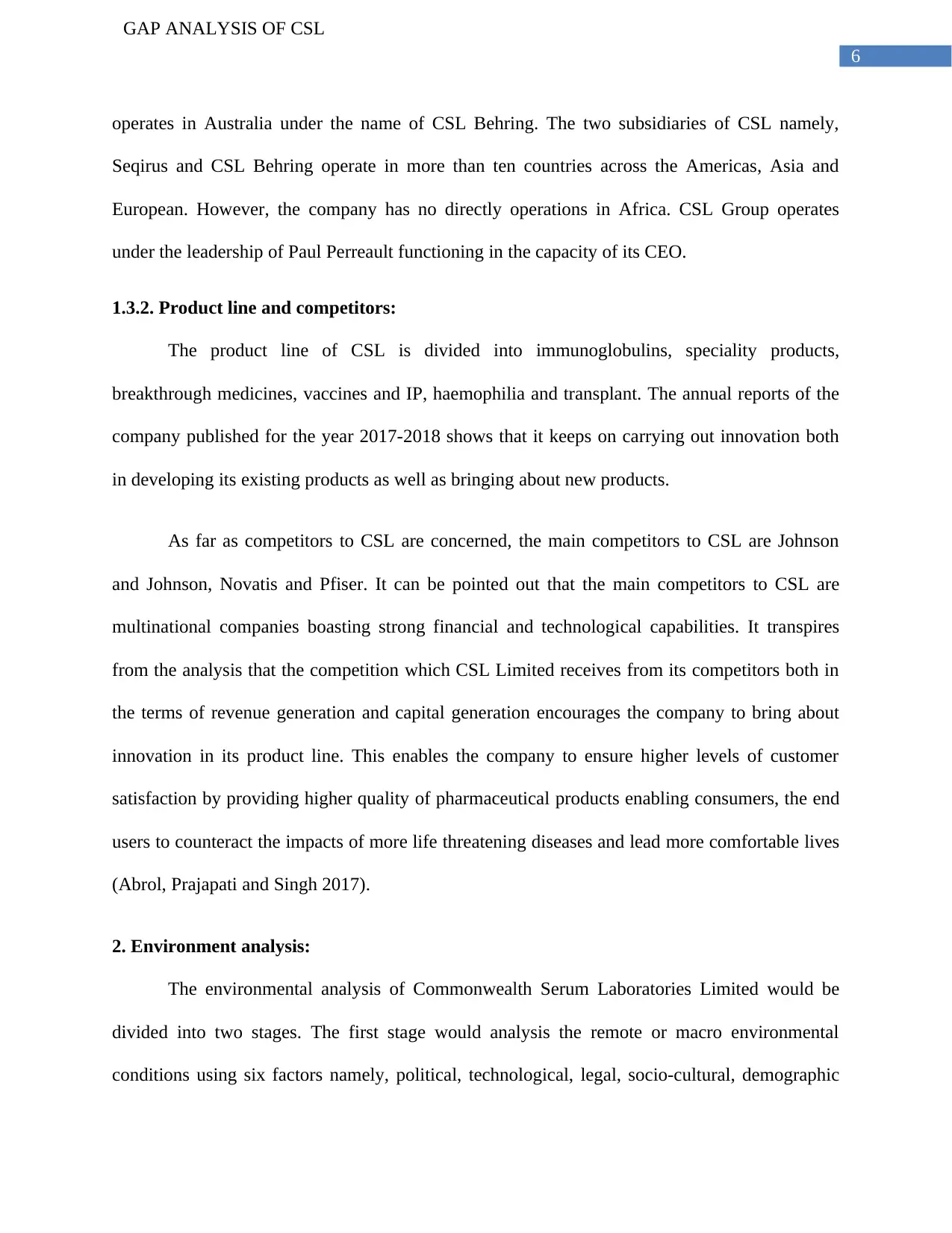
6
GAP ANALYSIS OF CSL
operates in Australia under the name of CSL Behring. The two subsidiaries of CSL namely,
Seqirus and CSL Behring operate in more than ten countries across the Americas, Asia and
European. However, the company has no directly operations in Africa. CSL Group operates
under the leadership of Paul Perreault functioning in the capacity of its CEO.
1.3.2. Product line and competitors:
The product line of CSL is divided into immunoglobulins, speciality products,
breakthrough medicines, vaccines and IP, haemophilia and transplant. The annual reports of the
company published for the year 2017-2018 shows that it keeps on carrying out innovation both
in developing its existing products as well as bringing about new products.
As far as competitors to CSL are concerned, the main competitors to CSL are Johnson
and Johnson, Novatis and Pfiser. It can be pointed out that the main competitors to CSL are
multinational companies boasting strong financial and technological capabilities. It transpires
from the analysis that the competition which CSL Limited receives from its competitors both in
the terms of revenue generation and capital generation encourages the company to bring about
innovation in its product line. This enables the company to ensure higher levels of customer
satisfaction by providing higher quality of pharmaceutical products enabling consumers, the end
users to counteract the impacts of more life threatening diseases and lead more comfortable lives
(Abrol, Prajapati and Singh 2017).
2. Environment analysis:
The environmental analysis of Commonwealth Serum Laboratories Limited would be
divided into two stages. The first stage would analysis the remote or macro environmental
conditions using six factors namely, political, technological, legal, socio-cultural, demographic
GAP ANALYSIS OF CSL
operates in Australia under the name of CSL Behring. The two subsidiaries of CSL namely,
Seqirus and CSL Behring operate in more than ten countries across the Americas, Asia and
European. However, the company has no directly operations in Africa. CSL Group operates
under the leadership of Paul Perreault functioning in the capacity of its CEO.
1.3.2. Product line and competitors:
The product line of CSL is divided into immunoglobulins, speciality products,
breakthrough medicines, vaccines and IP, haemophilia and transplant. The annual reports of the
company published for the year 2017-2018 shows that it keeps on carrying out innovation both
in developing its existing products as well as bringing about new products.
As far as competitors to CSL are concerned, the main competitors to CSL are Johnson
and Johnson, Novatis and Pfiser. It can be pointed out that the main competitors to CSL are
multinational companies boasting strong financial and technological capabilities. It transpires
from the analysis that the competition which CSL Limited receives from its competitors both in
the terms of revenue generation and capital generation encourages the company to bring about
innovation in its product line. This enables the company to ensure higher levels of customer
satisfaction by providing higher quality of pharmaceutical products enabling consumers, the end
users to counteract the impacts of more life threatening diseases and lead more comfortable lives
(Abrol, Prajapati and Singh 2017).
2. Environment analysis:
The environmental analysis of Commonwealth Serum Laboratories Limited would be
divided into two stages. The first stage would analysis the remote or macro environmental
conditions using six factors namely, political, technological, legal, socio-cultural, demographic
Paraphrase This Document
Need a fresh take? Get an instant paraphrase of this document with our AI Paraphraser
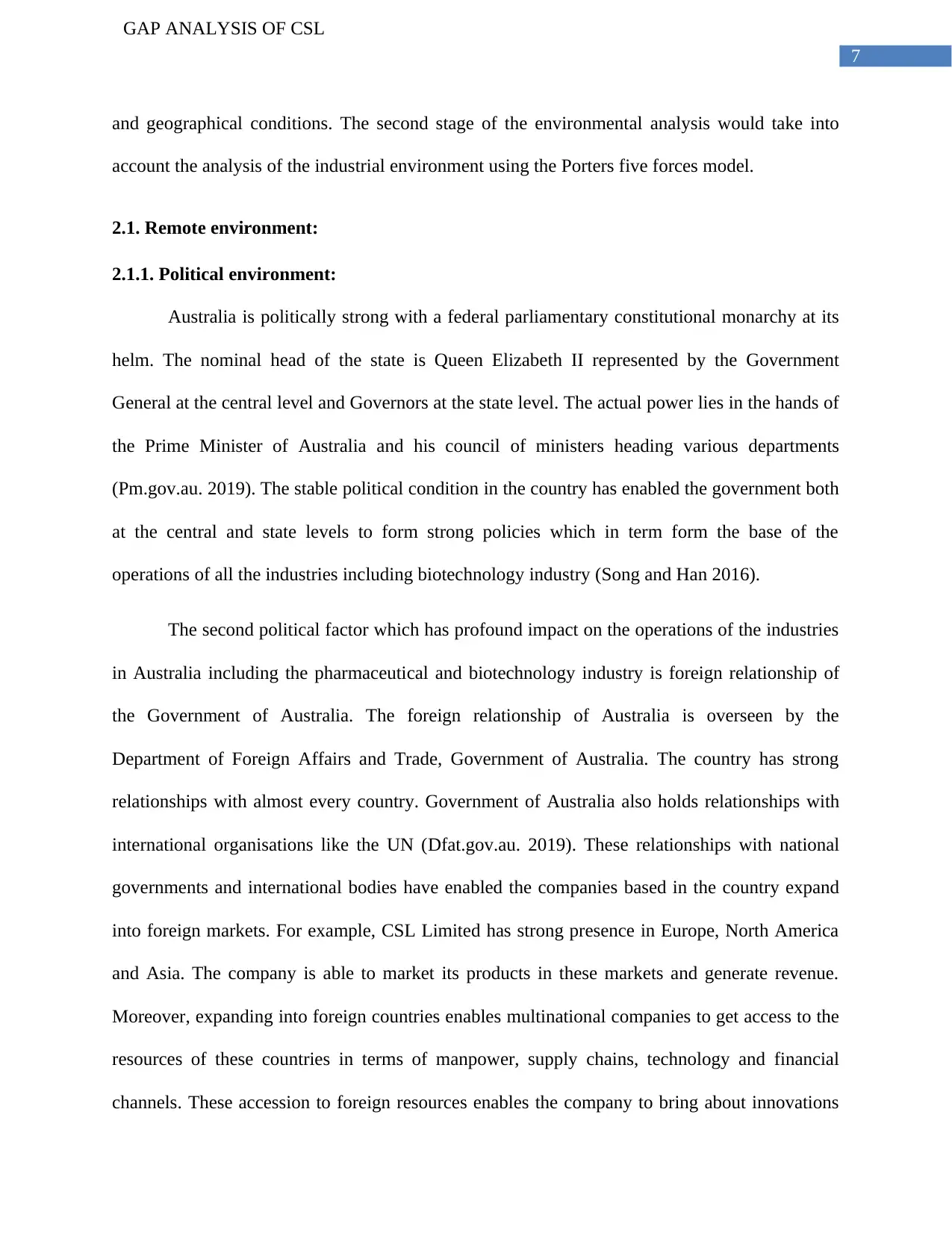
7
GAP ANALYSIS OF CSL
and geographical conditions. The second stage of the environmental analysis would take into
account the analysis of the industrial environment using the Porters five forces model.
2.1. Remote environment:
2.1.1. Political environment:
Australia is politically strong with a federal parliamentary constitutional monarchy at its
helm. The nominal head of the state is Queen Elizabeth II represented by the Government
General at the central level and Governors at the state level. The actual power lies in the hands of
the Prime Minister of Australia and his council of ministers heading various departments
(Pm.gov.au. 2019). The stable political condition in the country has enabled the government both
at the central and state levels to form strong policies which in term form the base of the
operations of all the industries including biotechnology industry (Song and Han 2016).
The second political factor which has profound impact on the operations of the industries
in Australia including the pharmaceutical and biotechnology industry is foreign relationship of
the Government of Australia. The foreign relationship of Australia is overseen by the
Department of Foreign Affairs and Trade, Government of Australia. The country has strong
relationships with almost every country. Government of Australia also holds relationships with
international organisations like the UN (Dfat.gov.au. 2019). These relationships with national
governments and international bodies have enabled the companies based in the country expand
into foreign markets. For example, CSL Limited has strong presence in Europe, North America
and Asia. The company is able to market its products in these markets and generate revenue.
Moreover, expanding into foreign countries enables multinational companies to get access to the
resources of these countries in terms of manpower, supply chains, technology and financial
channels. These accession to foreign resources enables the company to bring about innovations
GAP ANALYSIS OF CSL
and geographical conditions. The second stage of the environmental analysis would take into
account the analysis of the industrial environment using the Porters five forces model.
2.1. Remote environment:
2.1.1. Political environment:
Australia is politically strong with a federal parliamentary constitutional monarchy at its
helm. The nominal head of the state is Queen Elizabeth II represented by the Government
General at the central level and Governors at the state level. The actual power lies in the hands of
the Prime Minister of Australia and his council of ministers heading various departments
(Pm.gov.au. 2019). The stable political condition in the country has enabled the government both
at the central and state levels to form strong policies which in term form the base of the
operations of all the industries including biotechnology industry (Song and Han 2016).
The second political factor which has profound impact on the operations of the industries
in Australia including the pharmaceutical and biotechnology industry is foreign relationship of
the Government of Australia. The foreign relationship of Australia is overseen by the
Department of Foreign Affairs and Trade, Government of Australia. The country has strong
relationships with almost every country. Government of Australia also holds relationships with
international organisations like the UN (Dfat.gov.au. 2019). These relationships with national
governments and international bodies have enabled the companies based in the country expand
into foreign markets. For example, CSL Limited has strong presence in Europe, North America
and Asia. The company is able to market its products in these markets and generate revenue.
Moreover, expanding into foreign countries enables multinational companies to get access to the
resources of these countries in terms of manpower, supply chains, technology and financial
channels. These accession to foreign resources enables the company to bring about innovations
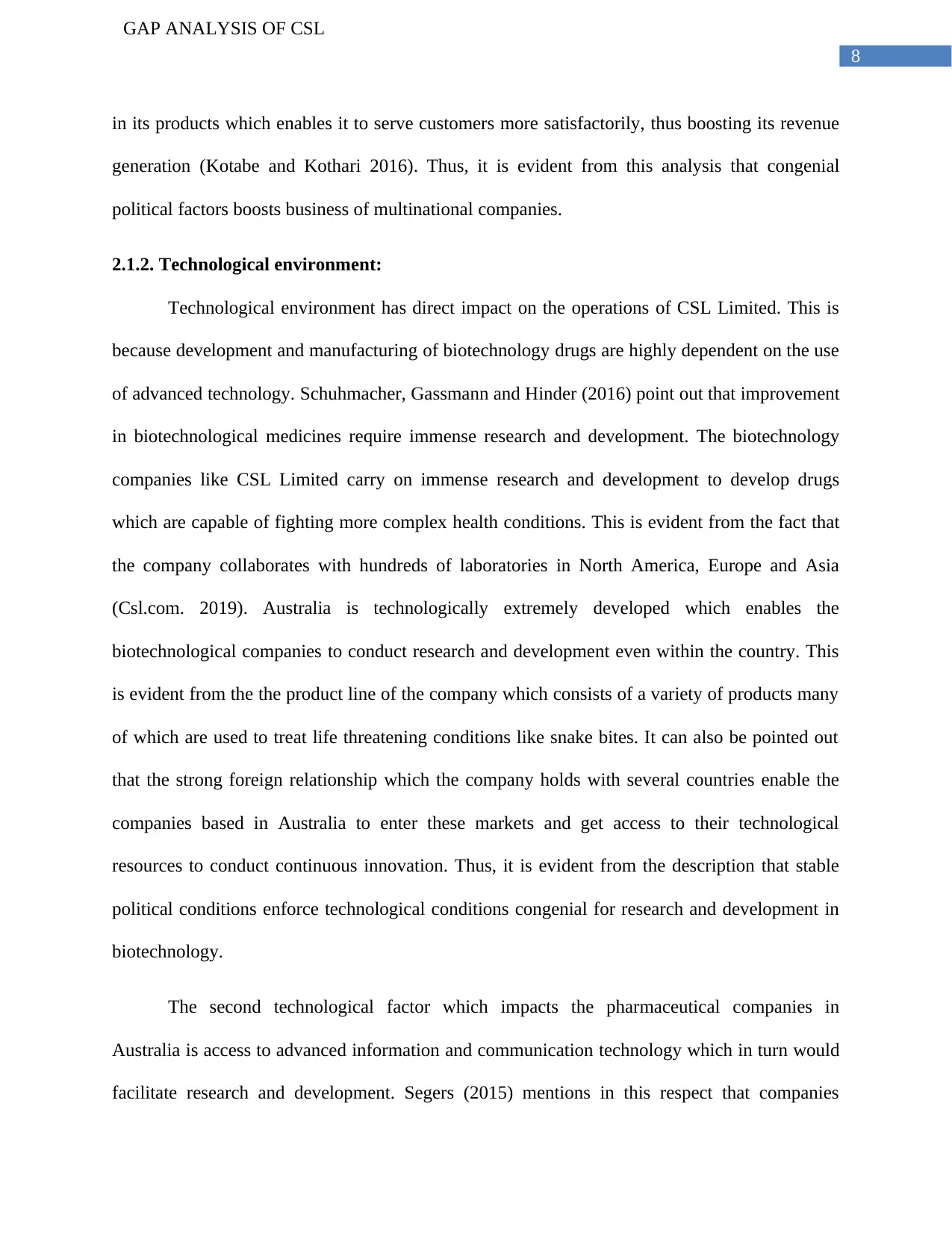
8
GAP ANALYSIS OF CSL
in its products which enables it to serve customers more satisfactorily, thus boosting its revenue
generation (Kotabe and Kothari 2016). Thus, it is evident from this analysis that congenial
political factors boosts business of multinational companies.
2.1.2. Technological environment:
Technological environment has direct impact on the operations of CSL Limited. This is
because development and manufacturing of biotechnology drugs are highly dependent on the use
of advanced technology. Schuhmacher, Gassmann and Hinder (2016) point out that improvement
in biotechnological medicines require immense research and development. The biotechnology
companies like CSL Limited carry on immense research and development to develop drugs
which are capable of fighting more complex health conditions. This is evident from the fact that
the company collaborates with hundreds of laboratories in North America, Europe and Asia
(Csl.com. 2019). Australia is technologically extremely developed which enables the
biotechnological companies to conduct research and development even within the country. This
is evident from the the product line of the company which consists of a variety of products many
of which are used to treat life threatening conditions like snake bites. It can also be pointed out
that the strong foreign relationship which the company holds with several countries enable the
companies based in Australia to enter these markets and get access to their technological
resources to conduct continuous innovation. Thus, it is evident from the description that stable
political conditions enforce technological conditions congenial for research and development in
biotechnology.
The second technological factor which impacts the pharmaceutical companies in
Australia is access to advanced information and communication technology which in turn would
facilitate research and development. Segers (2015) mentions in this respect that companies
GAP ANALYSIS OF CSL
in its products which enables it to serve customers more satisfactorily, thus boosting its revenue
generation (Kotabe and Kothari 2016). Thus, it is evident from this analysis that congenial
political factors boosts business of multinational companies.
2.1.2. Technological environment:
Technological environment has direct impact on the operations of CSL Limited. This is
because development and manufacturing of biotechnology drugs are highly dependent on the use
of advanced technology. Schuhmacher, Gassmann and Hinder (2016) point out that improvement
in biotechnological medicines require immense research and development. The biotechnology
companies like CSL Limited carry on immense research and development to develop drugs
which are capable of fighting more complex health conditions. This is evident from the fact that
the company collaborates with hundreds of laboratories in North America, Europe and Asia
(Csl.com. 2019). Australia is technologically extremely developed which enables the
biotechnological companies to conduct research and development even within the country. This
is evident from the the product line of the company which consists of a variety of products many
of which are used to treat life threatening conditions like snake bites. It can also be pointed out
that the strong foreign relationship which the company holds with several countries enable the
companies based in Australia to enter these markets and get access to their technological
resources to conduct continuous innovation. Thus, it is evident from the description that stable
political conditions enforce technological conditions congenial for research and development in
biotechnology.
The second technological factor which impacts the pharmaceutical companies in
Australia is access to advanced information and communication technology which in turn would
facilitate research and development. Segers (2015) mentions in this respect that companies
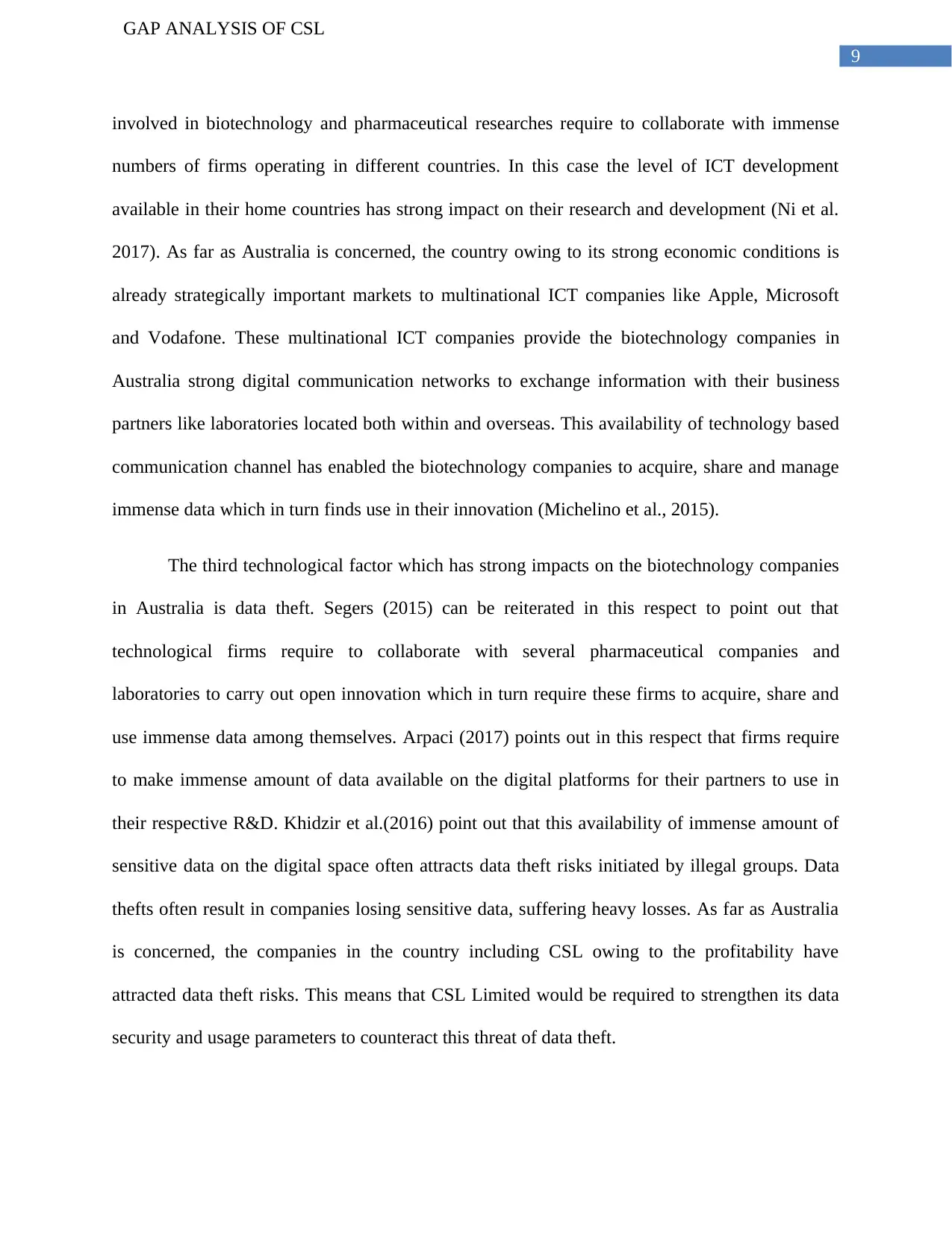
9
GAP ANALYSIS OF CSL
involved in biotechnology and pharmaceutical researches require to collaborate with immense
numbers of firms operating in different countries. In this case the level of ICT development
available in their home countries has strong impact on their research and development (Ni et al.
2017). As far as Australia is concerned, the country owing to its strong economic conditions is
already strategically important markets to multinational ICT companies like Apple, Microsoft
and Vodafone. These multinational ICT companies provide the biotechnology companies in
Australia strong digital communication networks to exchange information with their business
partners like laboratories located both within and overseas. This availability of technology based
communication channel has enabled the biotechnology companies to acquire, share and manage
immense data which in turn finds use in their innovation (Michelino et al., 2015).
The third technological factor which has strong impacts on the biotechnology companies
in Australia is data theft. Segers (2015) can be reiterated in this respect to point out that
technological firms require to collaborate with several pharmaceutical companies and
laboratories to carry out open innovation which in turn require these firms to acquire, share and
use immense data among themselves. Arpaci (2017) points out in this respect that firms require
to make immense amount of data available on the digital platforms for their partners to use in
their respective R&D. Khidzir et al.(2016) point out that this availability of immense amount of
sensitive data on the digital space often attracts data theft risks initiated by illegal groups. Data
thefts often result in companies losing sensitive data, suffering heavy losses. As far as Australia
is concerned, the companies in the country including CSL owing to the profitability have
attracted data theft risks. This means that CSL Limited would be required to strengthen its data
security and usage parameters to counteract this threat of data theft.
GAP ANALYSIS OF CSL
involved in biotechnology and pharmaceutical researches require to collaborate with immense
numbers of firms operating in different countries. In this case the level of ICT development
available in their home countries has strong impact on their research and development (Ni et al.
2017). As far as Australia is concerned, the country owing to its strong economic conditions is
already strategically important markets to multinational ICT companies like Apple, Microsoft
and Vodafone. These multinational ICT companies provide the biotechnology companies in
Australia strong digital communication networks to exchange information with their business
partners like laboratories located both within and overseas. This availability of technology based
communication channel has enabled the biotechnology companies to acquire, share and manage
immense data which in turn finds use in their innovation (Michelino et al., 2015).
The third technological factor which has strong impacts on the biotechnology companies
in Australia is data theft. Segers (2015) can be reiterated in this respect to point out that
technological firms require to collaborate with several pharmaceutical companies and
laboratories to carry out open innovation which in turn require these firms to acquire, share and
use immense data among themselves. Arpaci (2017) points out in this respect that firms require
to make immense amount of data available on the digital platforms for their partners to use in
their respective R&D. Khidzir et al.(2016) point out that this availability of immense amount of
sensitive data on the digital space often attracts data theft risks initiated by illegal groups. Data
thefts often result in companies losing sensitive data, suffering heavy losses. As far as Australia
is concerned, the companies in the country including CSL owing to the profitability have
attracted data theft risks. This means that CSL Limited would be required to strengthen its data
security and usage parameters to counteract this threat of data theft.
Secure Best Marks with AI Grader
Need help grading? Try our AI Grader for instant feedback on your assignments.
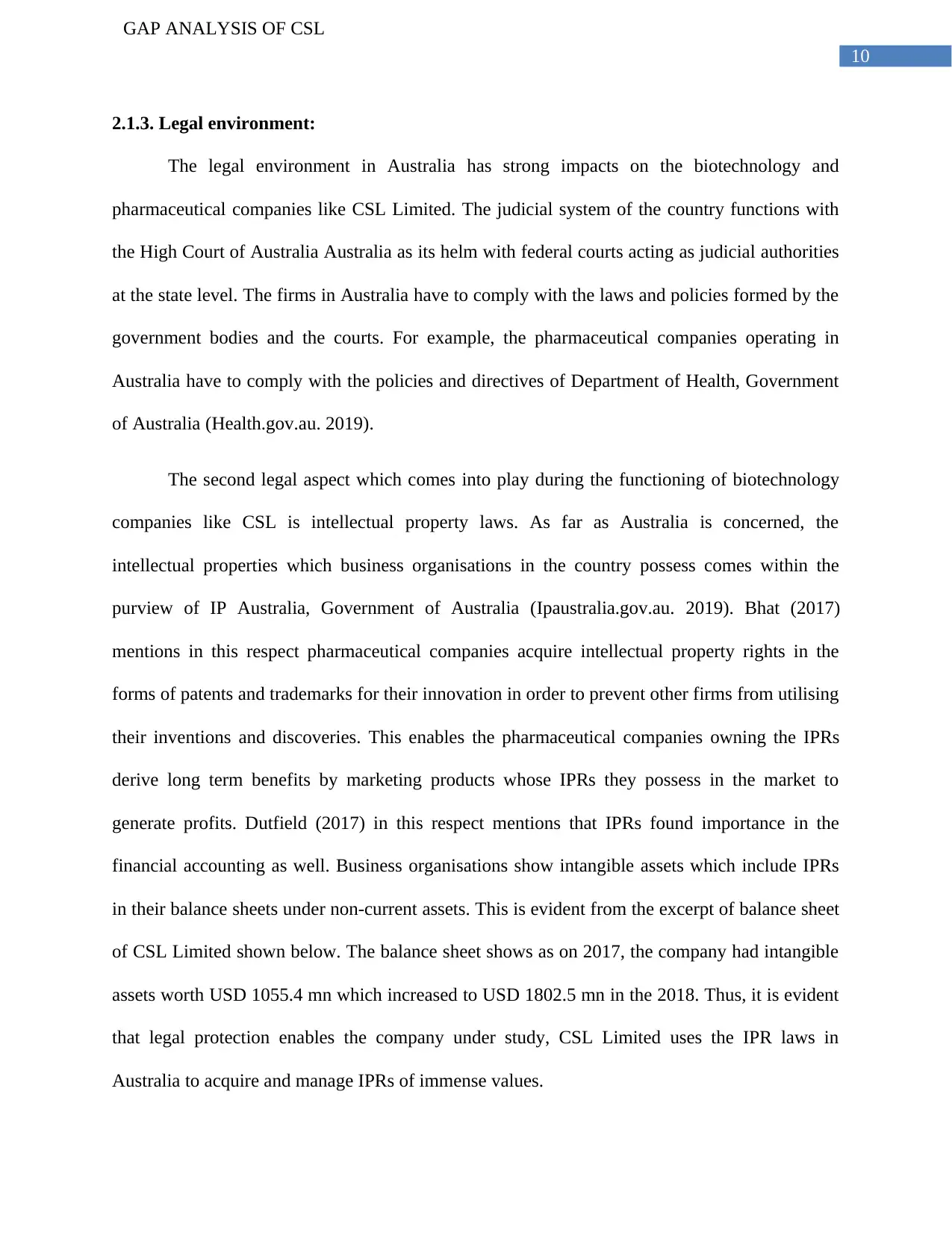
10
GAP ANALYSIS OF CSL
2.1.3. Legal environment:
The legal environment in Australia has strong impacts on the biotechnology and
pharmaceutical companies like CSL Limited. The judicial system of the country functions with
the High Court of Australia Australia as its helm with federal courts acting as judicial authorities
at the state level. The firms in Australia have to comply with the laws and policies formed by the
government bodies and the courts. For example, the pharmaceutical companies operating in
Australia have to comply with the policies and directives of Department of Health, Government
of Australia (Health.gov.au. 2019).
The second legal aspect which comes into play during the functioning of biotechnology
companies like CSL is intellectual property laws. As far as Australia is concerned, the
intellectual properties which business organisations in the country possess comes within the
purview of IP Australia, Government of Australia (Ipaustralia.gov.au. 2019). Bhat (2017)
mentions in this respect pharmaceutical companies acquire intellectual property rights in the
forms of patents and trademarks for their innovation in order to prevent other firms from utilising
their inventions and discoveries. This enables the pharmaceutical companies owning the IPRs
derive long term benefits by marketing products whose IPRs they possess in the market to
generate profits. Dutfield (2017) in this respect mentions that IPRs found importance in the
financial accounting as well. Business organisations show intangible assets which include IPRs
in their balance sheets under non-current assets. This is evident from the excerpt of balance sheet
of CSL Limited shown below. The balance sheet shows as on 2017, the company had intangible
assets worth USD 1055.4 mn which increased to USD 1802.5 mn in the 2018. Thus, it is evident
that legal protection enables the company under study, CSL Limited uses the IPR laws in
Australia to acquire and manage IPRs of immense values.
GAP ANALYSIS OF CSL
2.1.3. Legal environment:
The legal environment in Australia has strong impacts on the biotechnology and
pharmaceutical companies like CSL Limited. The judicial system of the country functions with
the High Court of Australia Australia as its helm with federal courts acting as judicial authorities
at the state level. The firms in Australia have to comply with the laws and policies formed by the
government bodies and the courts. For example, the pharmaceutical companies operating in
Australia have to comply with the policies and directives of Department of Health, Government
of Australia (Health.gov.au. 2019).
The second legal aspect which comes into play during the functioning of biotechnology
companies like CSL is intellectual property laws. As far as Australia is concerned, the
intellectual properties which business organisations in the country possess comes within the
purview of IP Australia, Government of Australia (Ipaustralia.gov.au. 2019). Bhat (2017)
mentions in this respect pharmaceutical companies acquire intellectual property rights in the
forms of patents and trademarks for their innovation in order to prevent other firms from utilising
their inventions and discoveries. This enables the pharmaceutical companies owning the IPRs
derive long term benefits by marketing products whose IPRs they possess in the market to
generate profits. Dutfield (2017) in this respect mentions that IPRs found importance in the
financial accounting as well. Business organisations show intangible assets which include IPRs
in their balance sheets under non-current assets. This is evident from the excerpt of balance sheet
of CSL Limited shown below. The balance sheet shows as on 2017, the company had intangible
assets worth USD 1055.4 mn which increased to USD 1802.5 mn in the 2018. Thus, it is evident
that legal protection enables the company under study, CSL Limited uses the IPR laws in
Australia to acquire and manage IPRs of immense values.
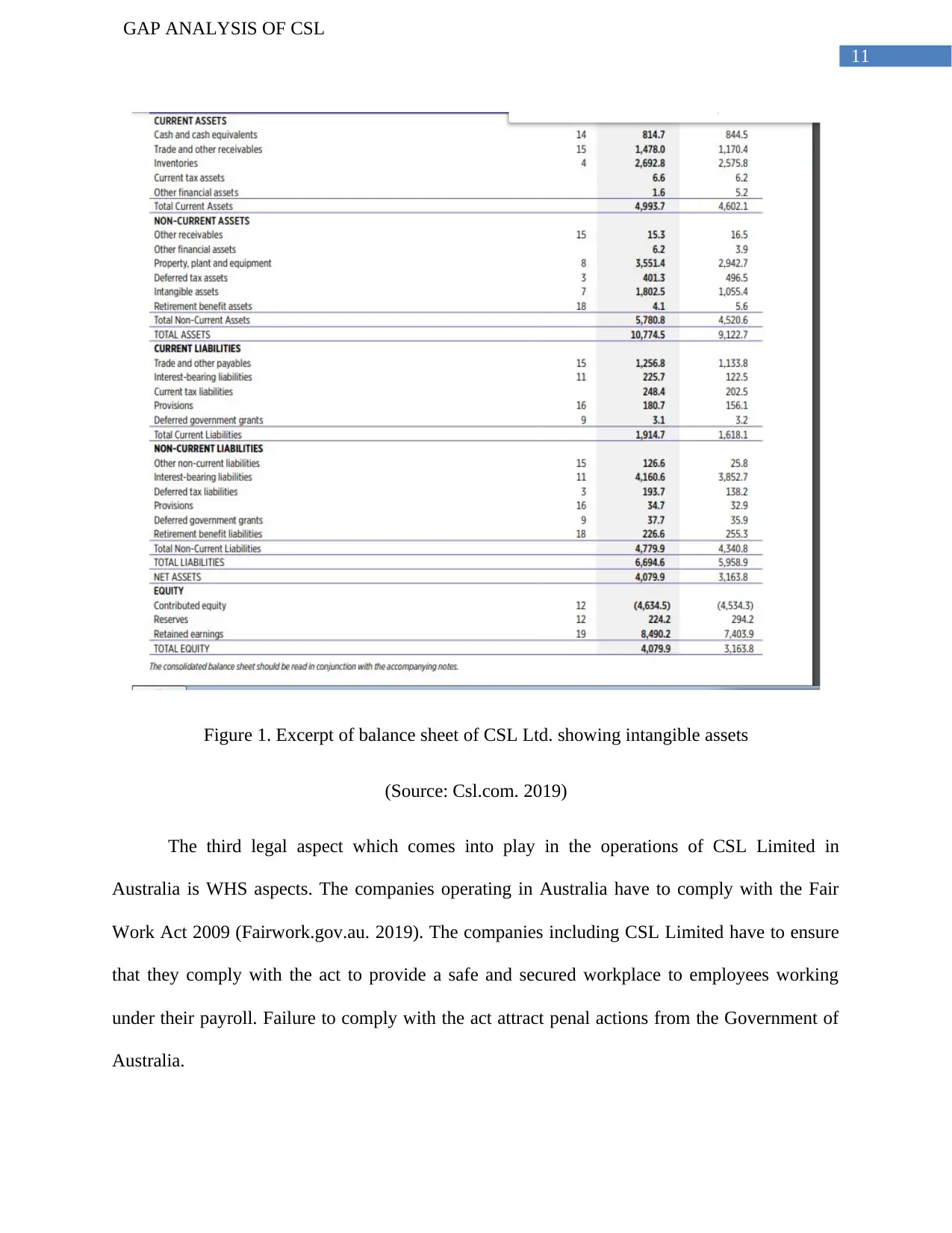
11
GAP ANALYSIS OF CSL
Figure 1. Excerpt of balance sheet of CSL Ltd. showing intangible assets
(Source: Csl.com. 2019)
The third legal aspect which comes into play in the operations of CSL Limited in
Australia is WHS aspects. The companies operating in Australia have to comply with the Fair
Work Act 2009 (Fairwork.gov.au. 2019). The companies including CSL Limited have to ensure
that they comply with the act to provide a safe and secured workplace to employees working
under their payroll. Failure to comply with the act attract penal actions from the Government of
Australia.
GAP ANALYSIS OF CSL
Figure 1. Excerpt of balance sheet of CSL Ltd. showing intangible assets
(Source: Csl.com. 2019)
The third legal aspect which comes into play in the operations of CSL Limited in
Australia is WHS aspects. The companies operating in Australia have to comply with the Fair
Work Act 2009 (Fairwork.gov.au. 2019). The companies including CSL Limited have to ensure
that they comply with the act to provide a safe and secured workplace to employees working
under their payroll. Failure to comply with the act attract penal actions from the Government of
Australia.
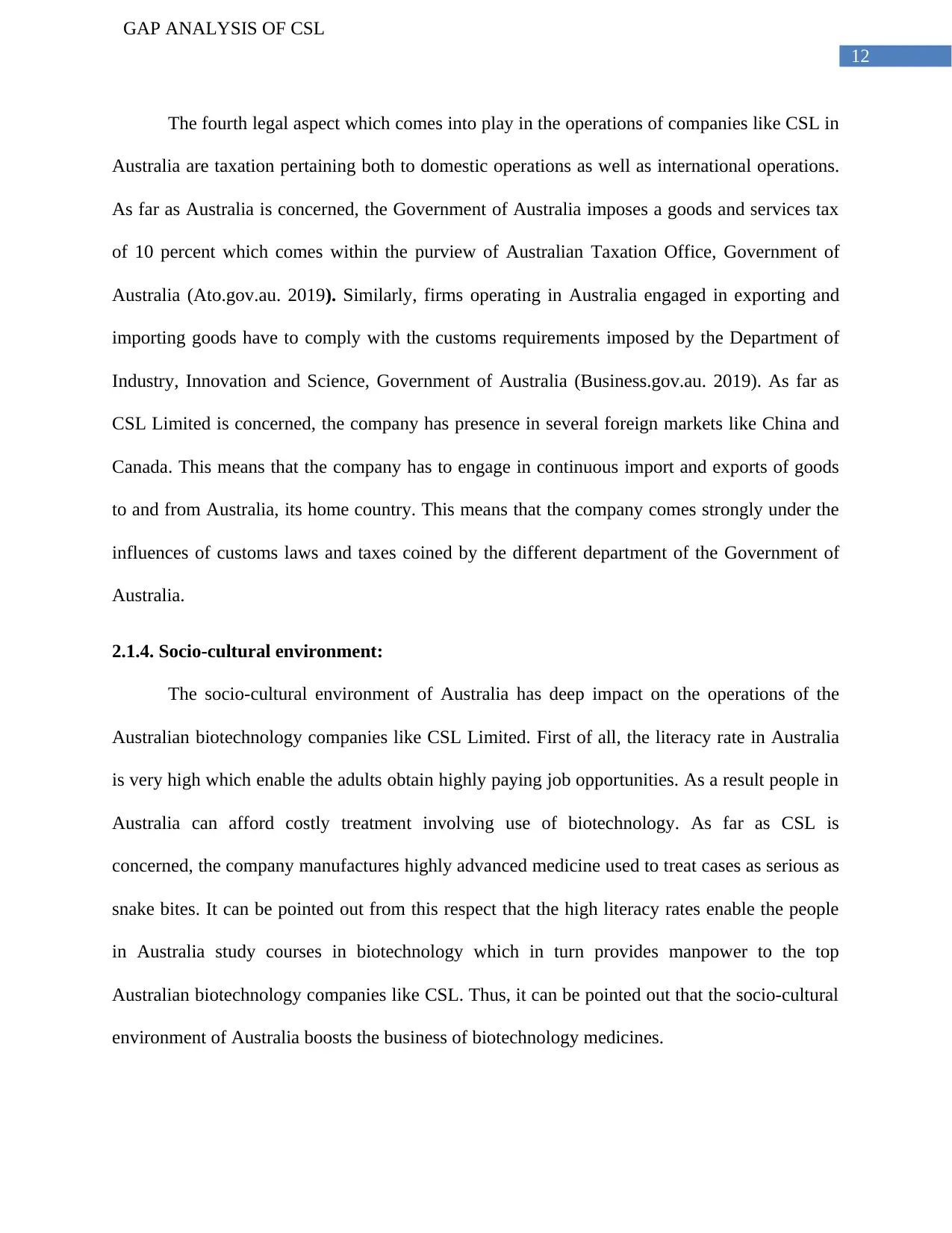
12
GAP ANALYSIS OF CSL
The fourth legal aspect which comes into play in the operations of companies like CSL in
Australia are taxation pertaining both to domestic operations as well as international operations.
As far as Australia is concerned, the Government of Australia imposes a goods and services tax
of 10 percent which comes within the purview of Australian Taxation Office, Government of
Australia (Ato.gov.au. 2019). Similarly, firms operating in Australia engaged in exporting and
importing goods have to comply with the customs requirements imposed by the Department of
Industry, Innovation and Science, Government of Australia (Business.gov.au. 2019). As far as
CSL Limited is concerned, the company has presence in several foreign markets like China and
Canada. This means that the company has to engage in continuous import and exports of goods
to and from Australia, its home country. This means that the company comes strongly under the
influences of customs laws and taxes coined by the different department of the Government of
Australia.
2.1.4. Socio-cultural environment:
The socio-cultural environment of Australia has deep impact on the operations of the
Australian biotechnology companies like CSL Limited. First of all, the literacy rate in Australia
is very high which enable the adults obtain highly paying job opportunities. As a result people in
Australia can afford costly treatment involving use of biotechnology. As far as CSL is
concerned, the company manufactures highly advanced medicine used to treat cases as serious as
snake bites. It can be pointed out from this respect that the high literacy rates enable the people
in Australia study courses in biotechnology which in turn provides manpower to the top
Australian biotechnology companies like CSL. Thus, it can be pointed out that the socio-cultural
environment of Australia boosts the business of biotechnology medicines.
GAP ANALYSIS OF CSL
The fourth legal aspect which comes into play in the operations of companies like CSL in
Australia are taxation pertaining both to domestic operations as well as international operations.
As far as Australia is concerned, the Government of Australia imposes a goods and services tax
of 10 percent which comes within the purview of Australian Taxation Office, Government of
Australia (Ato.gov.au. 2019). Similarly, firms operating in Australia engaged in exporting and
importing goods have to comply with the customs requirements imposed by the Department of
Industry, Innovation and Science, Government of Australia (Business.gov.au. 2019). As far as
CSL Limited is concerned, the company has presence in several foreign markets like China and
Canada. This means that the company has to engage in continuous import and exports of goods
to and from Australia, its home country. This means that the company comes strongly under the
influences of customs laws and taxes coined by the different department of the Government of
Australia.
2.1.4. Socio-cultural environment:
The socio-cultural environment of Australia has deep impact on the operations of the
Australian biotechnology companies like CSL Limited. First of all, the literacy rate in Australia
is very high which enable the adults obtain highly paying job opportunities. As a result people in
Australia can afford costly treatment involving use of biotechnology. As far as CSL is
concerned, the company manufactures highly advanced medicine used to treat cases as serious as
snake bites. It can be pointed out from this respect that the high literacy rates enable the people
in Australia study courses in biotechnology which in turn provides manpower to the top
Australian biotechnology companies like CSL. Thus, it can be pointed out that the socio-cultural
environment of Australia boosts the business of biotechnology medicines.
Paraphrase This Document
Need a fresh take? Get an instant paraphrase of this document with our AI Paraphraser
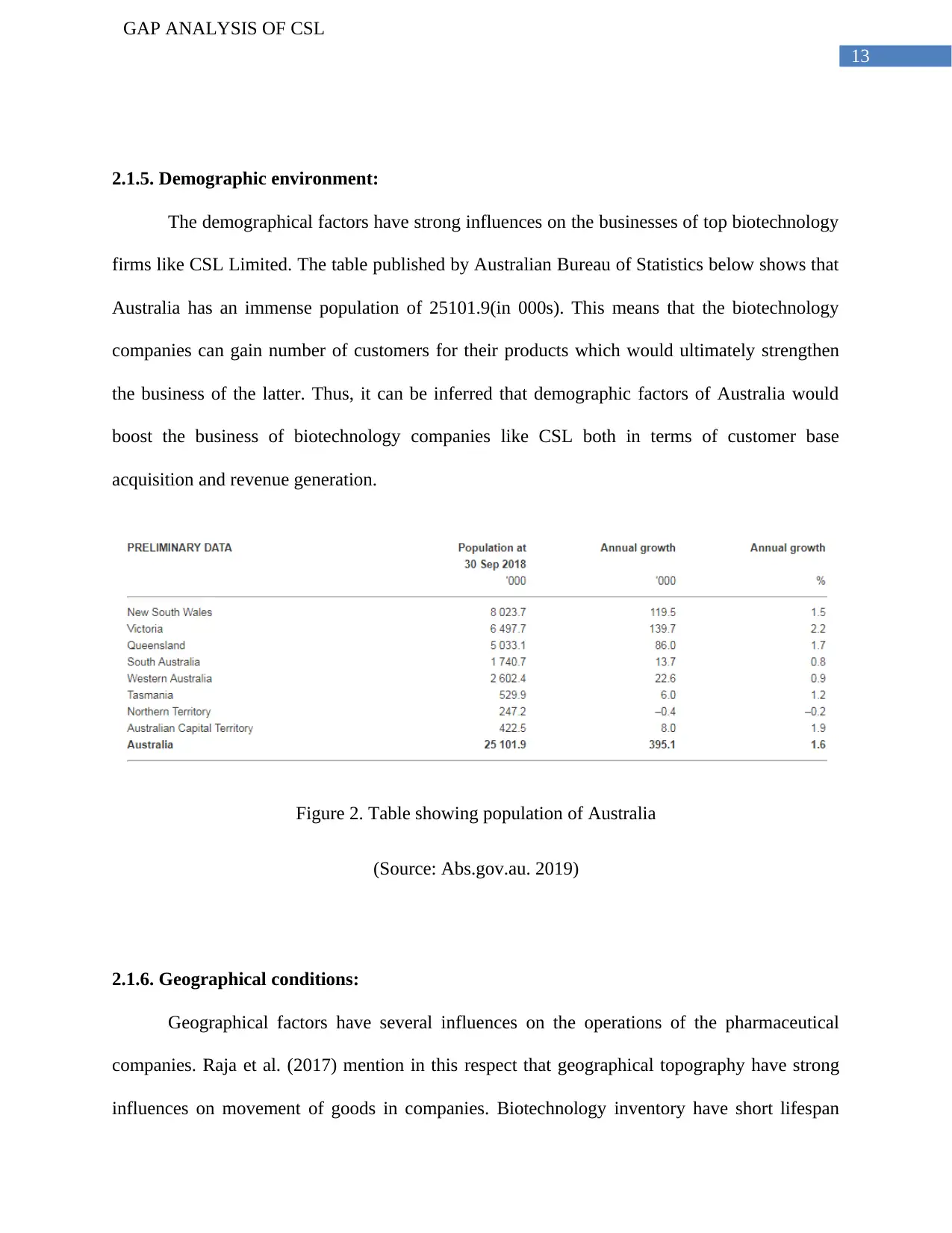
13
GAP ANALYSIS OF CSL
2.1.5. Demographic environment:
The demographical factors have strong influences on the businesses of top biotechnology
firms like CSL Limited. The table published by Australian Bureau of Statistics below shows that
Australia has an immense population of 25101.9(in 000s). This means that the biotechnology
companies can gain number of customers for their products which would ultimately strengthen
the business of the latter. Thus, it can be inferred that demographic factors of Australia would
boost the business of biotechnology companies like CSL both in terms of customer base
acquisition and revenue generation.
Figure 2. Table showing population of Australia
(Source: Abs.gov.au. 2019)
2.1.6. Geographical conditions:
Geographical factors have several influences on the operations of the pharmaceutical
companies. Raja et al. (2017) mention in this respect that geographical topography have strong
influences on movement of goods in companies. Biotechnology inventory have short lifespan
GAP ANALYSIS OF CSL
2.1.5. Demographic environment:
The demographical factors have strong influences on the businesses of top biotechnology
firms like CSL Limited. The table published by Australian Bureau of Statistics below shows that
Australia has an immense population of 25101.9(in 000s). This means that the biotechnology
companies can gain number of customers for their products which would ultimately strengthen
the business of the latter. Thus, it can be inferred that demographic factors of Australia would
boost the business of biotechnology companies like CSL both in terms of customer base
acquisition and revenue generation.
Figure 2. Table showing population of Australia
(Source: Abs.gov.au. 2019)
2.1.6. Geographical conditions:
Geographical factors have several influences on the operations of the pharmaceutical
companies. Raja et al. (2017) mention in this respect that geographical topography have strong
influences on movement of goods in companies. Biotechnology inventory have short lifespan
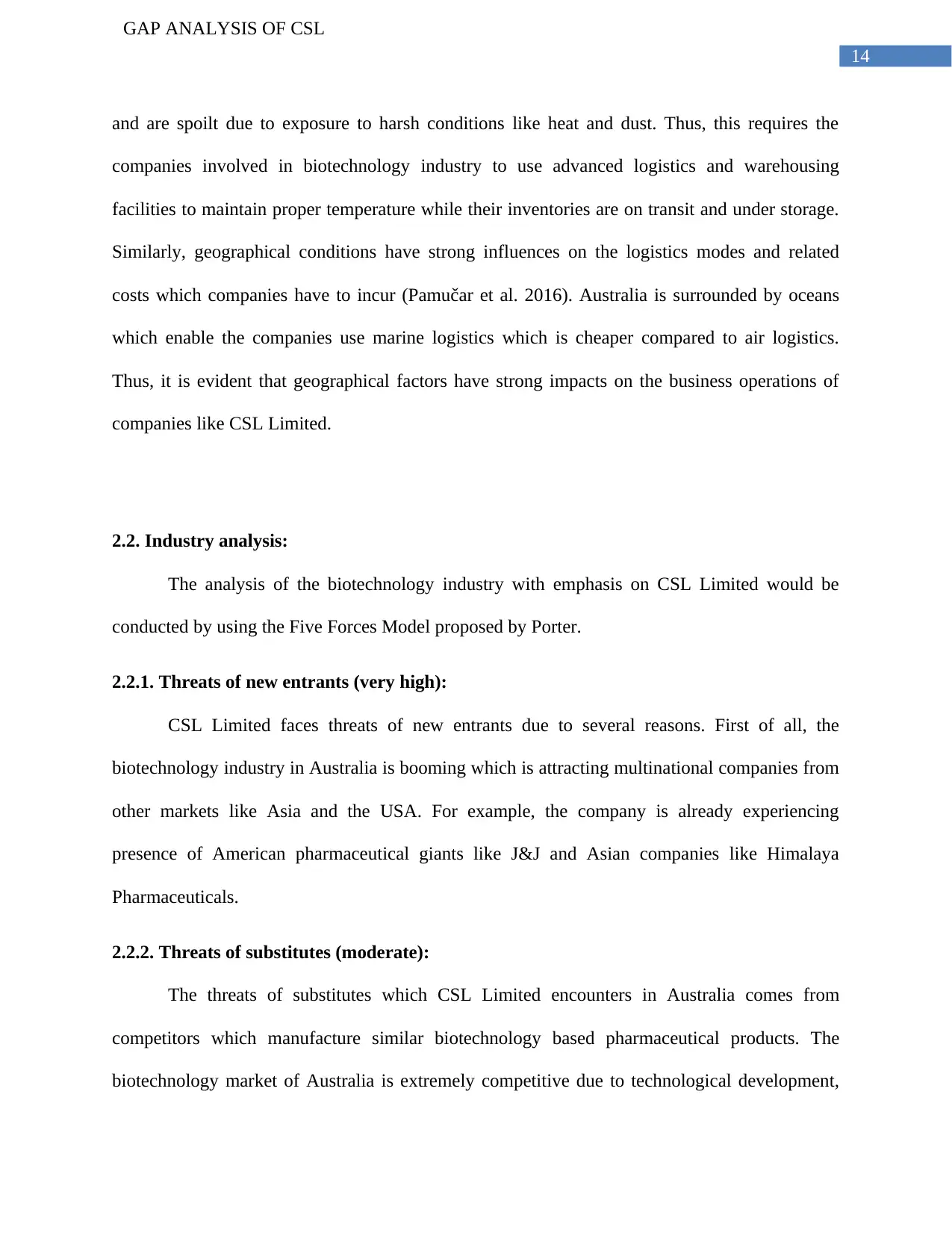
14
GAP ANALYSIS OF CSL
and are spoilt due to exposure to harsh conditions like heat and dust. Thus, this requires the
companies involved in biotechnology industry to use advanced logistics and warehousing
facilities to maintain proper temperature while their inventories are on transit and under storage.
Similarly, geographical conditions have strong influences on the logistics modes and related
costs which companies have to incur (Pamučar et al. 2016). Australia is surrounded by oceans
which enable the companies use marine logistics which is cheaper compared to air logistics.
Thus, it is evident that geographical factors have strong impacts on the business operations of
companies like CSL Limited.
2.2. Industry analysis:
The analysis of the biotechnology industry with emphasis on CSL Limited would be
conducted by using the Five Forces Model proposed by Porter.
2.2.1. Threats of new entrants (very high):
CSL Limited faces threats of new entrants due to several reasons. First of all, the
biotechnology industry in Australia is booming which is attracting multinational companies from
other markets like Asia and the USA. For example, the company is already experiencing
presence of American pharmaceutical giants like J&J and Asian companies like Himalaya
Pharmaceuticals.
2.2.2. Threats of substitutes (moderate):
The threats of substitutes which CSL Limited encounters in Australia comes from
competitors which manufacture similar biotechnology based pharmaceutical products. The
biotechnology market of Australia is extremely competitive due to technological development,
GAP ANALYSIS OF CSL
and are spoilt due to exposure to harsh conditions like heat and dust. Thus, this requires the
companies involved in biotechnology industry to use advanced logistics and warehousing
facilities to maintain proper temperature while their inventories are on transit and under storage.
Similarly, geographical conditions have strong influences on the logistics modes and related
costs which companies have to incur (Pamučar et al. 2016). Australia is surrounded by oceans
which enable the companies use marine logistics which is cheaper compared to air logistics.
Thus, it is evident that geographical factors have strong impacts on the business operations of
companies like CSL Limited.
2.2. Industry analysis:
The analysis of the biotechnology industry with emphasis on CSL Limited would be
conducted by using the Five Forces Model proposed by Porter.
2.2.1. Threats of new entrants (very high):
CSL Limited faces threats of new entrants due to several reasons. First of all, the
biotechnology industry in Australia is booming which is attracting multinational companies from
other markets like Asia and the USA. For example, the company is already experiencing
presence of American pharmaceutical giants like J&J and Asian companies like Himalaya
Pharmaceuticals.
2.2.2. Threats of substitutes (moderate):
The threats of substitutes which CSL Limited encounters in Australia comes from
competitors which manufacture similar biotechnology based pharmaceutical products. The
biotechnology market of Australia is extremely competitive due to technological development,
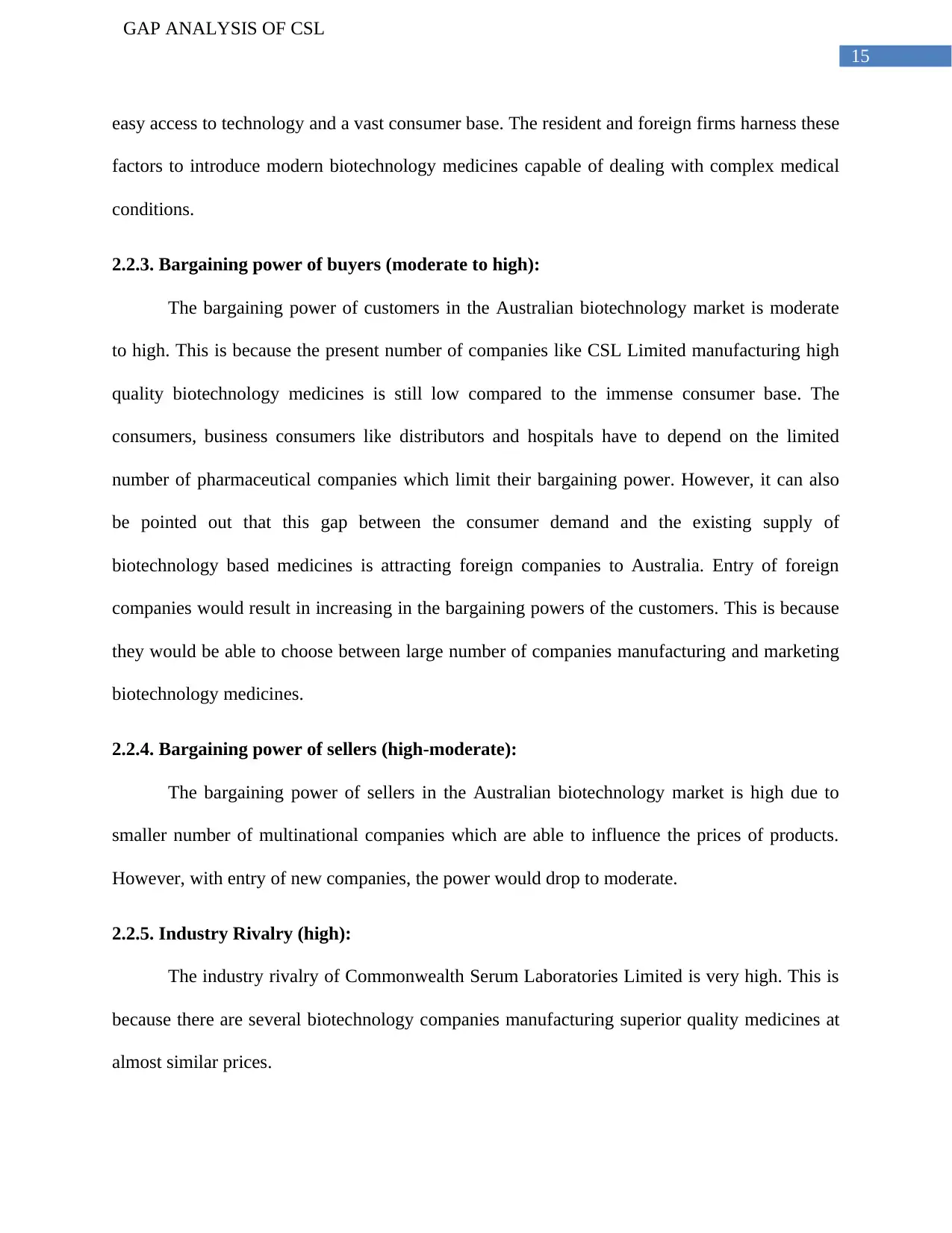
15
GAP ANALYSIS OF CSL
easy access to technology and a vast consumer base. The resident and foreign firms harness these
factors to introduce modern biotechnology medicines capable of dealing with complex medical
conditions.
2.2.3. Bargaining power of buyers (moderate to high):
The bargaining power of customers in the Australian biotechnology market is moderate
to high. This is because the present number of companies like CSL Limited manufacturing high
quality biotechnology medicines is still low compared to the immense consumer base. The
consumers, business consumers like distributors and hospitals have to depend on the limited
number of pharmaceutical companies which limit their bargaining power. However, it can also
be pointed out that this gap between the consumer demand and the existing supply of
biotechnology based medicines is attracting foreign companies to Australia. Entry of foreign
companies would result in increasing in the bargaining powers of the customers. This is because
they would be able to choose between large number of companies manufacturing and marketing
biotechnology medicines.
2.2.4. Bargaining power of sellers (high-moderate):
The bargaining power of sellers in the Australian biotechnology market is high due to
smaller number of multinational companies which are able to influence the prices of products.
However, with entry of new companies, the power would drop to moderate.
2.2.5. Industry Rivalry (high):
The industry rivalry of Commonwealth Serum Laboratories Limited is very high. This is
because there are several biotechnology companies manufacturing superior quality medicines at
almost similar prices.
GAP ANALYSIS OF CSL
easy access to technology and a vast consumer base. The resident and foreign firms harness these
factors to introduce modern biotechnology medicines capable of dealing with complex medical
conditions.
2.2.3. Bargaining power of buyers (moderate to high):
The bargaining power of customers in the Australian biotechnology market is moderate
to high. This is because the present number of companies like CSL Limited manufacturing high
quality biotechnology medicines is still low compared to the immense consumer base. The
consumers, business consumers like distributors and hospitals have to depend on the limited
number of pharmaceutical companies which limit their bargaining power. However, it can also
be pointed out that this gap between the consumer demand and the existing supply of
biotechnology based medicines is attracting foreign companies to Australia. Entry of foreign
companies would result in increasing in the bargaining powers of the customers. This is because
they would be able to choose between large number of companies manufacturing and marketing
biotechnology medicines.
2.2.4. Bargaining power of sellers (high-moderate):
The bargaining power of sellers in the Australian biotechnology market is high due to
smaller number of multinational companies which are able to influence the prices of products.
However, with entry of new companies, the power would drop to moderate.
2.2.5. Industry Rivalry (high):
The industry rivalry of Commonwealth Serum Laboratories Limited is very high. This is
because there are several biotechnology companies manufacturing superior quality medicines at
almost similar prices.
Secure Best Marks with AI Grader
Need help grading? Try our AI Grader for instant feedback on your assignments.
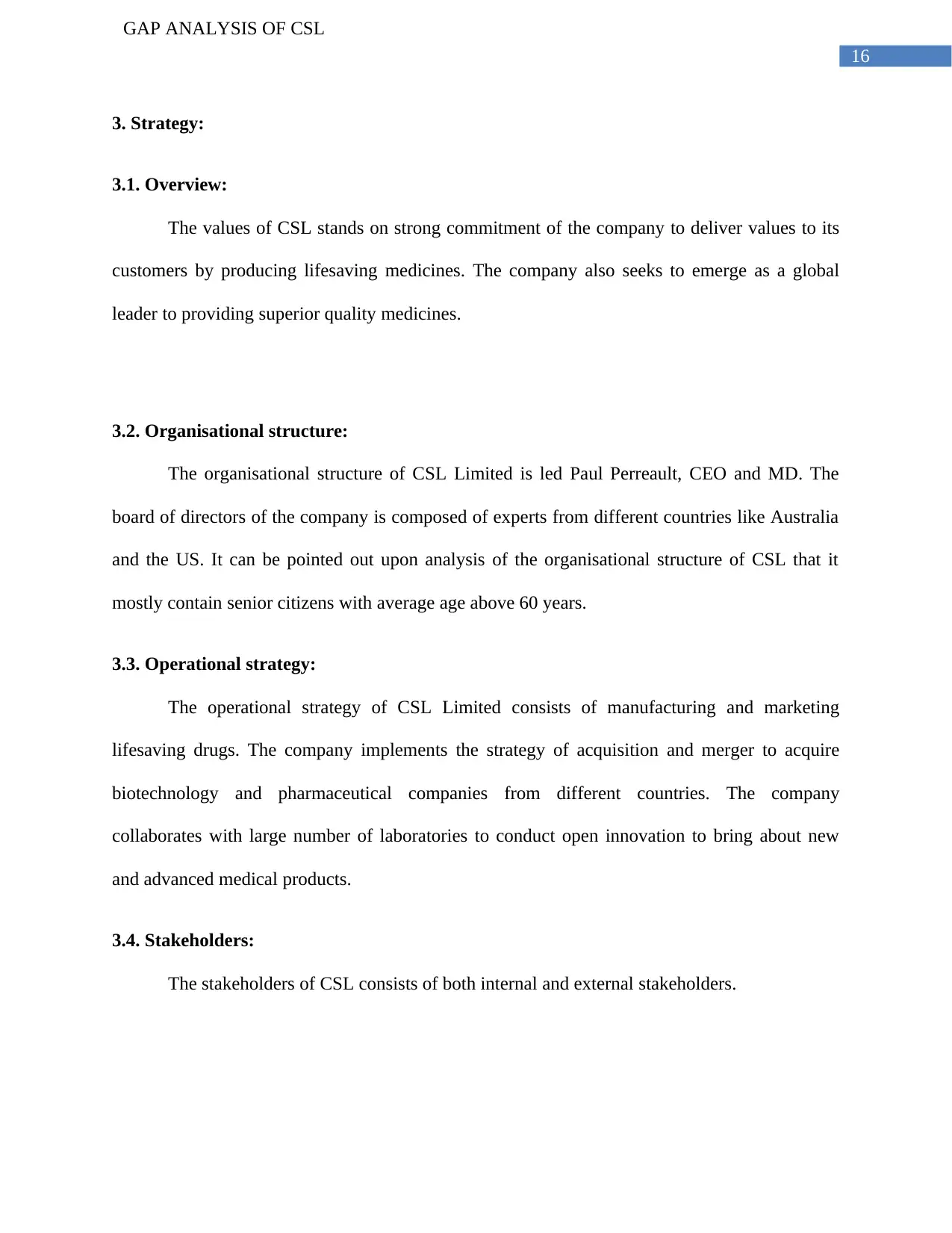
16
GAP ANALYSIS OF CSL
3. Strategy:
3.1. Overview:
The values of CSL stands on strong commitment of the company to deliver values to its
customers by producing lifesaving medicines. The company also seeks to emerge as a global
leader to providing superior quality medicines.
3.2. Organisational structure:
The organisational structure of CSL Limited is led Paul Perreault, CEO and MD. The
board of directors of the company is composed of experts from different countries like Australia
and the US. It can be pointed out upon analysis of the organisational structure of CSL that it
mostly contain senior citizens with average age above 60 years.
3.3. Operational strategy:
The operational strategy of CSL Limited consists of manufacturing and marketing
lifesaving drugs. The company implements the strategy of acquisition and merger to acquire
biotechnology and pharmaceutical companies from different countries. The company
collaborates with large number of laboratories to conduct open innovation to bring about new
and advanced medical products.
3.4. Stakeholders:
The stakeholders of CSL consists of both internal and external stakeholders.
GAP ANALYSIS OF CSL
3. Strategy:
3.1. Overview:
The values of CSL stands on strong commitment of the company to deliver values to its
customers by producing lifesaving medicines. The company also seeks to emerge as a global
leader to providing superior quality medicines.
3.2. Organisational structure:
The organisational structure of CSL Limited is led Paul Perreault, CEO and MD. The
board of directors of the company is composed of experts from different countries like Australia
and the US. It can be pointed out upon analysis of the organisational structure of CSL that it
mostly contain senior citizens with average age above 60 years.
3.3. Operational strategy:
The operational strategy of CSL Limited consists of manufacturing and marketing
lifesaving drugs. The company implements the strategy of acquisition and merger to acquire
biotechnology and pharmaceutical companies from different countries. The company
collaborates with large number of laboratories to conduct open innovation to bring about new
and advanced medical products.
3.4. Stakeholders:
The stakeholders of CSL consists of both internal and external stakeholders.
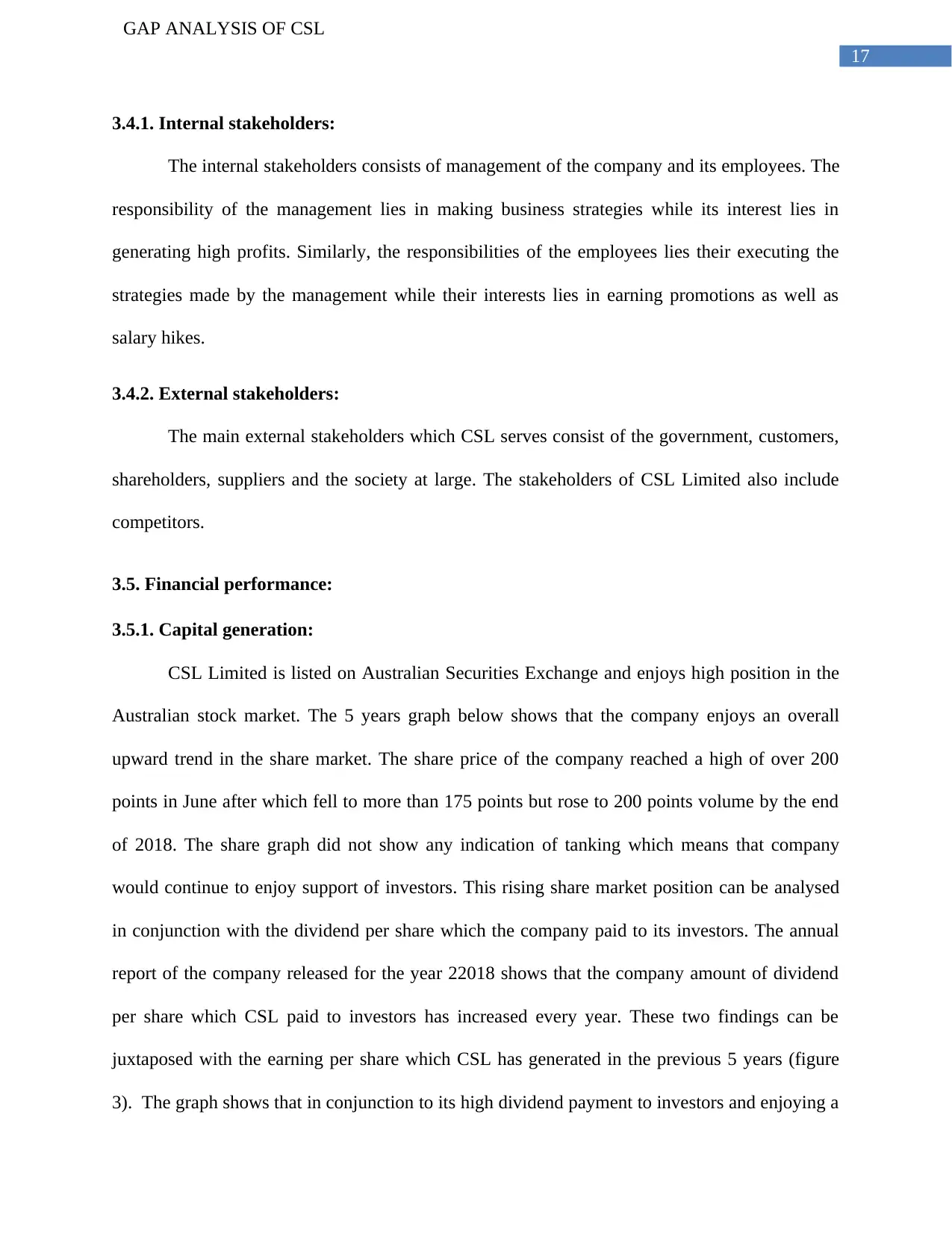
17
GAP ANALYSIS OF CSL
3.4.1. Internal stakeholders:
The internal stakeholders consists of management of the company and its employees. The
responsibility of the management lies in making business strategies while its interest lies in
generating high profits. Similarly, the responsibilities of the employees lies their executing the
strategies made by the management while their interests lies in earning promotions as well as
salary hikes.
3.4.2. External stakeholders:
The main external stakeholders which CSL serves consist of the government, customers,
shareholders, suppliers and the society at large. The stakeholders of CSL Limited also include
competitors.
3.5. Financial performance:
3.5.1. Capital generation:
CSL Limited is listed on Australian Securities Exchange and enjoys high position in the
Australian stock market. The 5 years graph below shows that the company enjoys an overall
upward trend in the share market. The share price of the company reached a high of over 200
points in June after which fell to more than 175 points but rose to 200 points volume by the end
of 2018. The share graph did not show any indication of tanking which means that company
would continue to enjoy support of investors. This rising share market position can be analysed
in conjunction with the dividend per share which the company paid to its investors. The annual
report of the company released for the year 22018 shows that the company amount of dividend
per share which CSL paid to investors has increased every year. These two findings can be
juxtaposed with the earning per share which CSL has generated in the previous 5 years (figure
3). The graph shows that in conjunction to its high dividend payment to investors and enjoying a
GAP ANALYSIS OF CSL
3.4.1. Internal stakeholders:
The internal stakeholders consists of management of the company and its employees. The
responsibility of the management lies in making business strategies while its interest lies in
generating high profits. Similarly, the responsibilities of the employees lies their executing the
strategies made by the management while their interests lies in earning promotions as well as
salary hikes.
3.4.2. External stakeholders:
The main external stakeholders which CSL serves consist of the government, customers,
shareholders, suppliers and the society at large. The stakeholders of CSL Limited also include
competitors.
3.5. Financial performance:
3.5.1. Capital generation:
CSL Limited is listed on Australian Securities Exchange and enjoys high position in the
Australian stock market. The 5 years graph below shows that the company enjoys an overall
upward trend in the share market. The share price of the company reached a high of over 200
points in June after which fell to more than 175 points but rose to 200 points volume by the end
of 2018. The share graph did not show any indication of tanking which means that company
would continue to enjoy support of investors. This rising share market position can be analysed
in conjunction with the dividend per share which the company paid to its investors. The annual
report of the company released for the year 22018 shows that the company amount of dividend
per share which CSL paid to investors has increased every year. These two findings can be
juxtaposed with the earning per share which CSL has generated in the previous 5 years (figure
3). The graph shows that in conjunction to its high dividend payment to investors and enjoying a
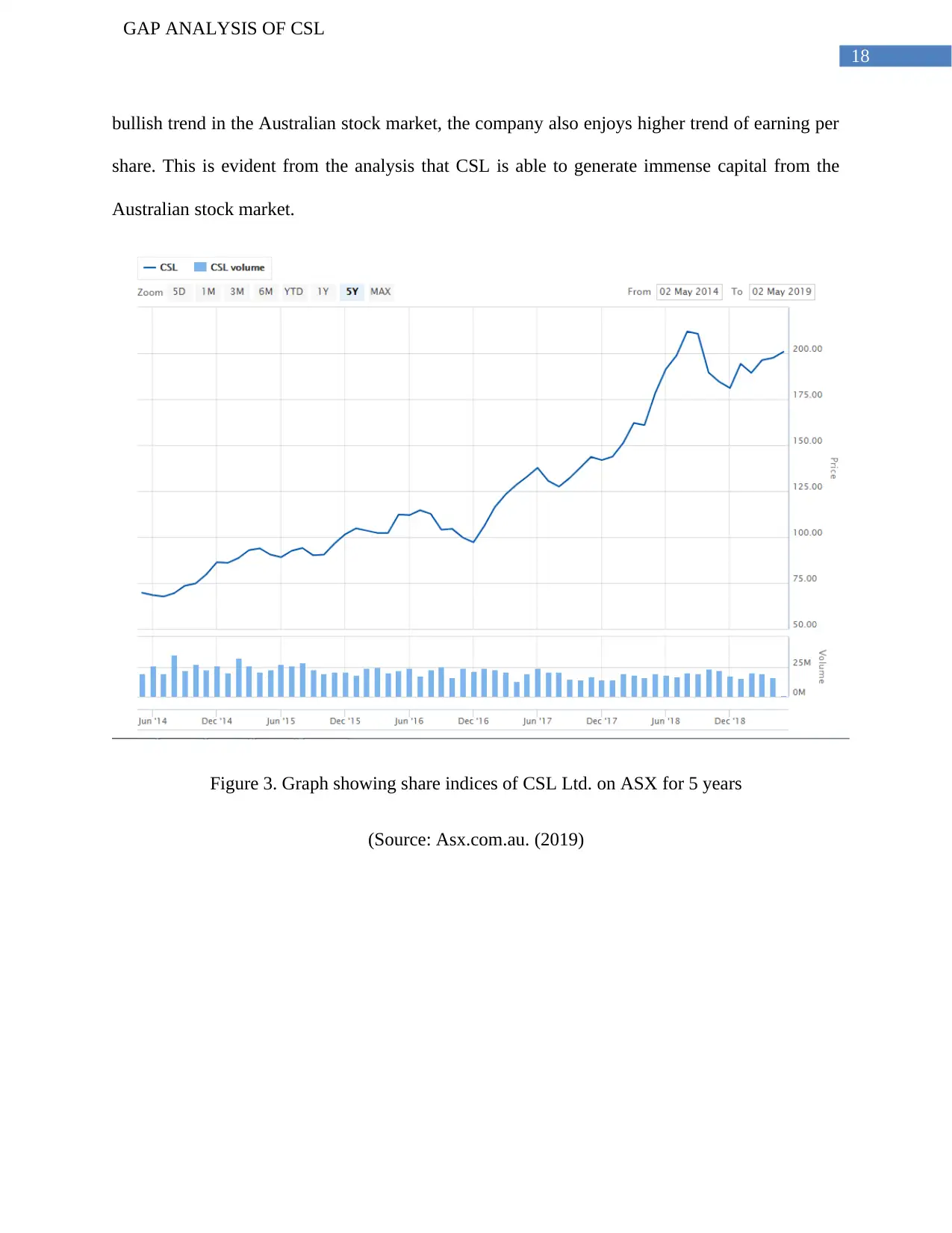
18
GAP ANALYSIS OF CSL
bullish trend in the Australian stock market, the company also enjoys higher trend of earning per
share. This is evident from the analysis that CSL is able to generate immense capital from the
Australian stock market.
Figure 3. Graph showing share indices of CSL Ltd. on ASX for 5 years
(Source: Asx.com.au. (2019)
GAP ANALYSIS OF CSL
bullish trend in the Australian stock market, the company also enjoys higher trend of earning per
share. This is evident from the analysis that CSL is able to generate immense capital from the
Australian stock market.
Figure 3. Graph showing share indices of CSL Ltd. on ASX for 5 years
(Source: Asx.com.au. (2019)
Paraphrase This Document
Need a fresh take? Get an instant paraphrase of this document with our AI Paraphraser
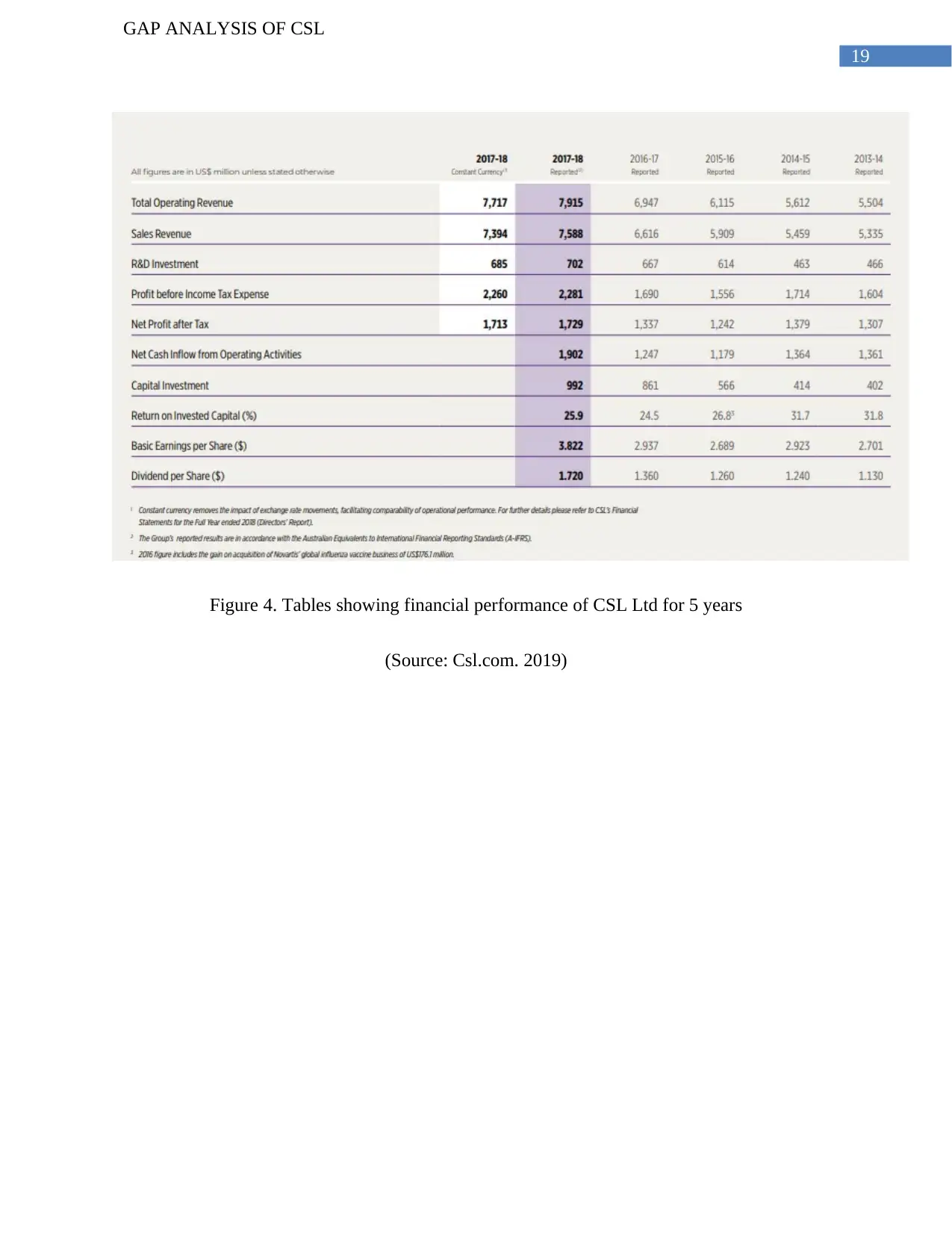
19
GAP ANALYSIS OF CSL
Figure 4. Tables showing financial performance of CSL Ltd for 5 years
(Source: Csl.com. 2019)
GAP ANALYSIS OF CSL
Figure 4. Tables showing financial performance of CSL Ltd for 5 years
(Source: Csl.com. 2019)
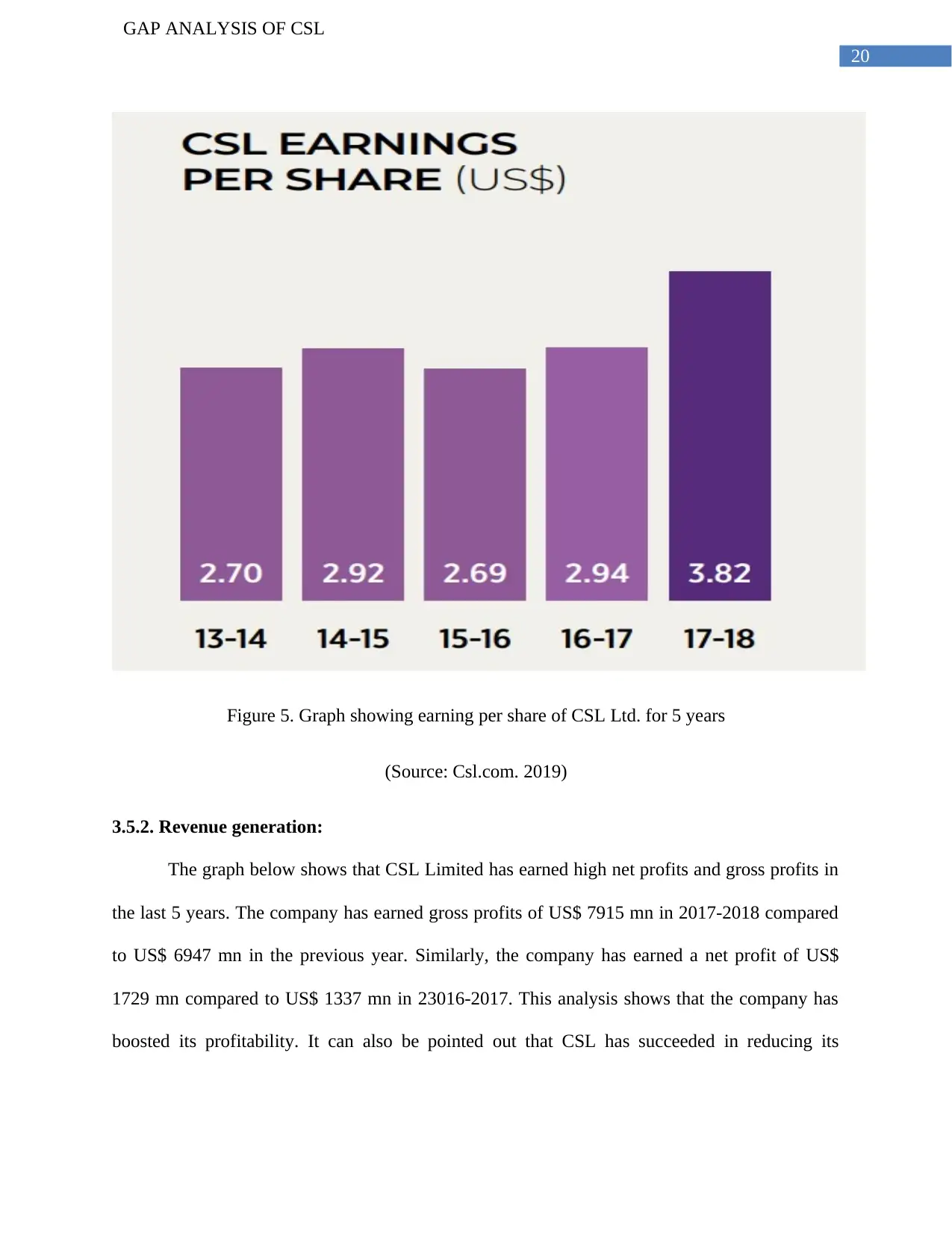
20
GAP ANALYSIS OF CSL
Figure 5. Graph showing earning per share of CSL Ltd. for 5 years
(Source: Csl.com. 2019)
3.5.2. Revenue generation:
The graph below shows that CSL Limited has earned high net profits and gross profits in
the last 5 years. The company has earned gross profits of US$ 7915 mn in 2017-2018 compared
to US$ 6947 mn in the previous year. Similarly, the company has earned a net profit of US$
1729 mn compared to US$ 1337 mn in 23016-2017. This analysis shows that the company has
boosted its profitability. It can also be pointed out that CSL has succeeded in reducing its
GAP ANALYSIS OF CSL
Figure 5. Graph showing earning per share of CSL Ltd. for 5 years
(Source: Csl.com. 2019)
3.5.2. Revenue generation:
The graph below shows that CSL Limited has earned high net profits and gross profits in
the last 5 years. The company has earned gross profits of US$ 7915 mn in 2017-2018 compared
to US$ 6947 mn in the previous year. Similarly, the company has earned a net profit of US$
1729 mn compared to US$ 1337 mn in 23016-2017. This analysis shows that the company has
boosted its profitability. It can also be pointed out that CSL has succeeded in reducing its
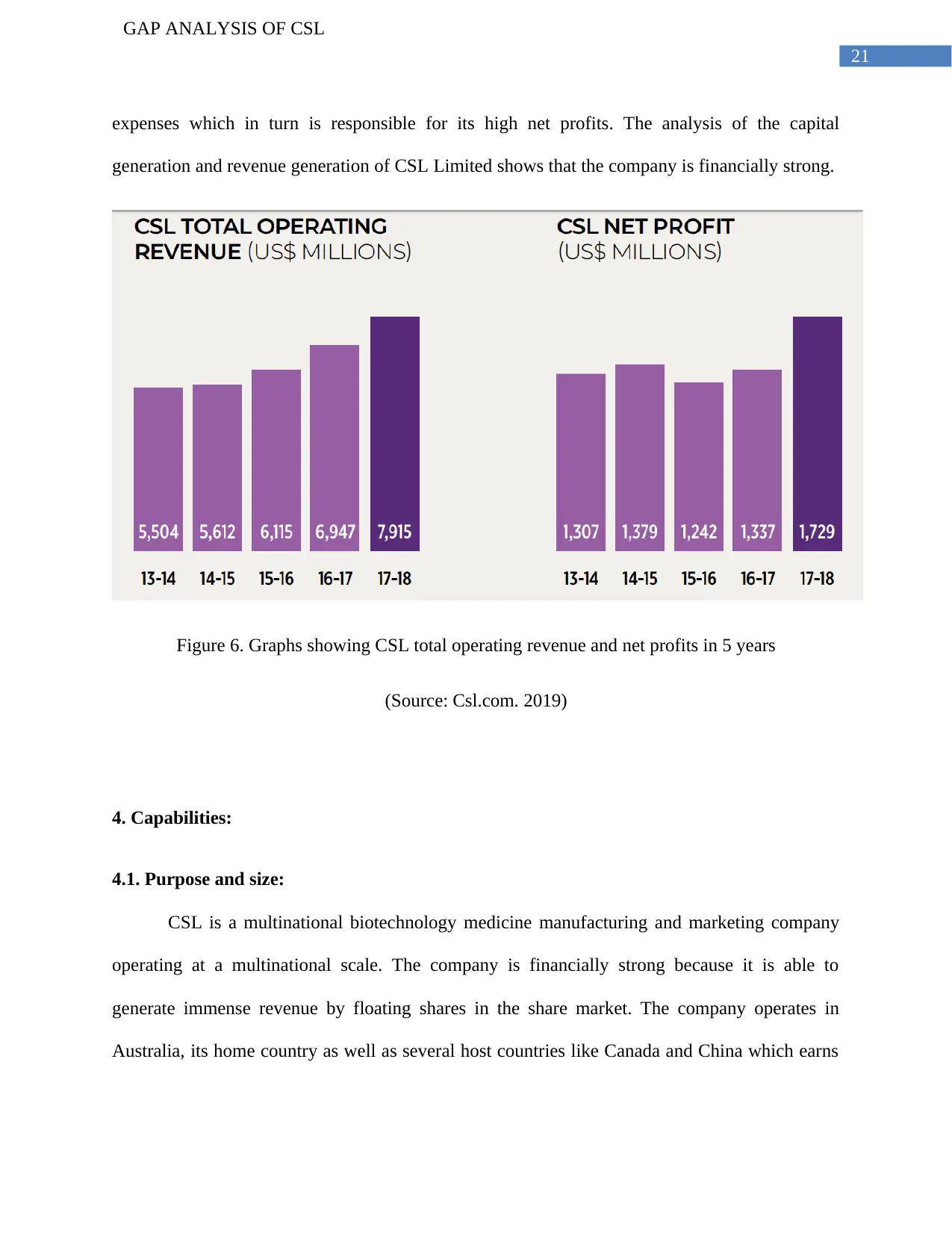
21
GAP ANALYSIS OF CSL
expenses which in turn is responsible for its high net profits. The analysis of the capital
generation and revenue generation of CSL Limited shows that the company is financially strong.
Figure 6. Graphs showing CSL total operating revenue and net profits in 5 years
(Source: Csl.com. 2019)
4. Capabilities:
4.1. Purpose and size:
CSL is a multinational biotechnology medicine manufacturing and marketing company
operating at a multinational scale. The company is financially strong because it is able to
generate immense revenue by floating shares in the share market. The company operates in
Australia, its home country as well as several host countries like Canada and China which earns
GAP ANALYSIS OF CSL
expenses which in turn is responsible for its high net profits. The analysis of the capital
generation and revenue generation of CSL Limited shows that the company is financially strong.
Figure 6. Graphs showing CSL total operating revenue and net profits in 5 years
(Source: Csl.com. 2019)
4. Capabilities:
4.1. Purpose and size:
CSL is a multinational biotechnology medicine manufacturing and marketing company
operating at a multinational scale. The company is financially strong because it is able to
generate immense revenue by floating shares in the share market. The company operates in
Australia, its home country as well as several host countries like Canada and China which earns
Secure Best Marks with AI Grader
Need help grading? Try our AI Grader for instant feedback on your assignments.
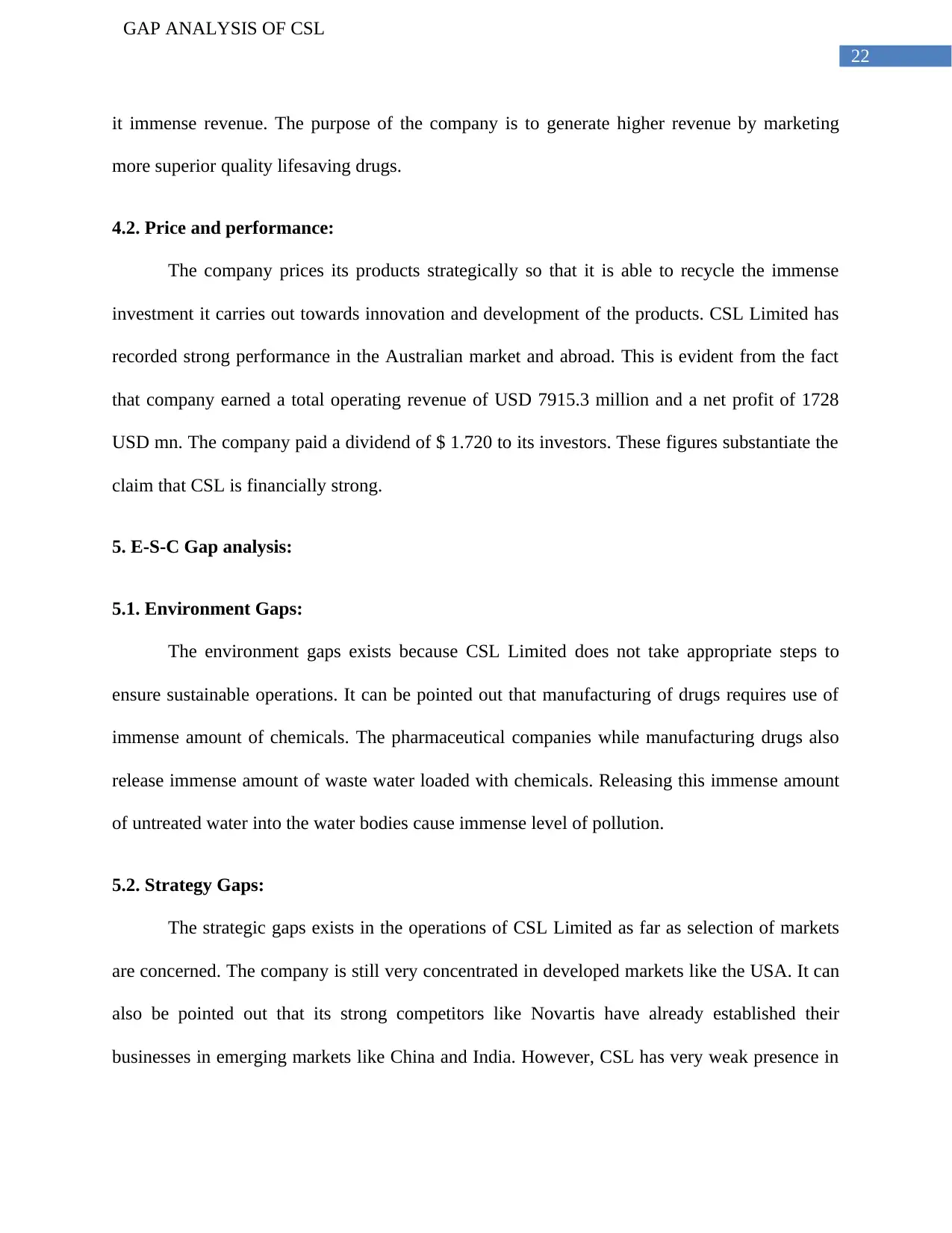
22
GAP ANALYSIS OF CSL
it immense revenue. The purpose of the company is to generate higher revenue by marketing
more superior quality lifesaving drugs.
4.2. Price and performance:
The company prices its products strategically so that it is able to recycle the immense
investment it carries out towards innovation and development of the products. CSL Limited has
recorded strong performance in the Australian market and abroad. This is evident from the fact
that company earned a total operating revenue of USD 7915.3 million and a net profit of 1728
USD mn. The company paid a dividend of $ 1.720 to its investors. These figures substantiate the
claim that CSL is financially strong.
5. E-S-C Gap analysis:
5.1. Environment Gaps:
The environment gaps exists because CSL Limited does not take appropriate steps to
ensure sustainable operations. It can be pointed out that manufacturing of drugs requires use of
immense amount of chemicals. The pharmaceutical companies while manufacturing drugs also
release immense amount of waste water loaded with chemicals. Releasing this immense amount
of untreated water into the water bodies cause immense level of pollution.
5.2. Strategy Gaps:
The strategic gaps exists in the operations of CSL Limited as far as selection of markets
are concerned. The company is still very concentrated in developed markets like the USA. It can
also be pointed out that its strong competitors like Novartis have already established their
businesses in emerging markets like China and India. However, CSL has very weak presence in
GAP ANALYSIS OF CSL
it immense revenue. The purpose of the company is to generate higher revenue by marketing
more superior quality lifesaving drugs.
4.2. Price and performance:
The company prices its products strategically so that it is able to recycle the immense
investment it carries out towards innovation and development of the products. CSL Limited has
recorded strong performance in the Australian market and abroad. This is evident from the fact
that company earned a total operating revenue of USD 7915.3 million and a net profit of 1728
USD mn. The company paid a dividend of $ 1.720 to its investors. These figures substantiate the
claim that CSL is financially strong.
5. E-S-C Gap analysis:
5.1. Environment Gaps:
The environment gaps exists because CSL Limited does not take appropriate steps to
ensure sustainable operations. It can be pointed out that manufacturing of drugs requires use of
immense amount of chemicals. The pharmaceutical companies while manufacturing drugs also
release immense amount of waste water loaded with chemicals. Releasing this immense amount
of untreated water into the water bodies cause immense level of pollution.
5.2. Strategy Gaps:
The strategic gaps exists in the operations of CSL Limited as far as selection of markets
are concerned. The company is still very concentrated in developed markets like the USA. It can
also be pointed out that its strong competitors like Novartis have already established their
businesses in emerging markets like China and India. However, CSL has very weak presence in
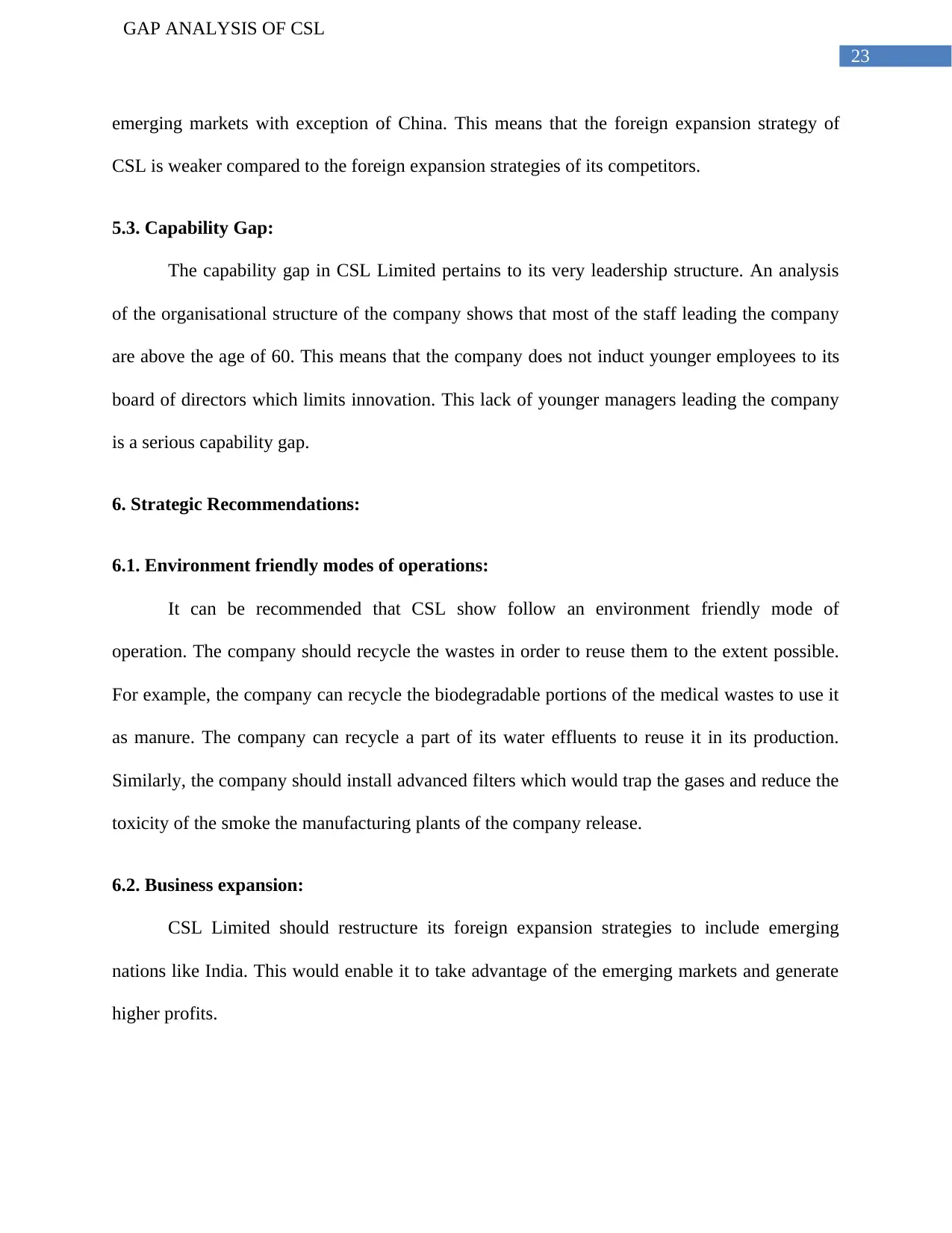
23
GAP ANALYSIS OF CSL
emerging markets with exception of China. This means that the foreign expansion strategy of
CSL is weaker compared to the foreign expansion strategies of its competitors.
5.3. Capability Gap:
The capability gap in CSL Limited pertains to its very leadership structure. An analysis
of the organisational structure of the company shows that most of the staff leading the company
are above the age of 60. This means that the company does not induct younger employees to its
board of directors which limits innovation. This lack of younger managers leading the company
is a serious capability gap.
6. Strategic Recommendations:
6.1. Environment friendly modes of operations:
It can be recommended that CSL show follow an environment friendly mode of
operation. The company should recycle the wastes in order to reuse them to the extent possible.
For example, the company can recycle the biodegradable portions of the medical wastes to use it
as manure. The company can recycle a part of its water effluents to reuse it in its production.
Similarly, the company should install advanced filters which would trap the gases and reduce the
toxicity of the smoke the manufacturing plants of the company release.
6.2. Business expansion:
CSL Limited should restructure its foreign expansion strategies to include emerging
nations like India. This would enable it to take advantage of the emerging markets and generate
higher profits.
GAP ANALYSIS OF CSL
emerging markets with exception of China. This means that the foreign expansion strategy of
CSL is weaker compared to the foreign expansion strategies of its competitors.
5.3. Capability Gap:
The capability gap in CSL Limited pertains to its very leadership structure. An analysis
of the organisational structure of the company shows that most of the staff leading the company
are above the age of 60. This means that the company does not induct younger employees to its
board of directors which limits innovation. This lack of younger managers leading the company
is a serious capability gap.
6. Strategic Recommendations:
6.1. Environment friendly modes of operations:
It can be recommended that CSL show follow an environment friendly mode of
operation. The company should recycle the wastes in order to reuse them to the extent possible.
For example, the company can recycle the biodegradable portions of the medical wastes to use it
as manure. The company can recycle a part of its water effluents to reuse it in its production.
Similarly, the company should install advanced filters which would trap the gases and reduce the
toxicity of the smoke the manufacturing plants of the company release.
6.2. Business expansion:
CSL Limited should restructure its foreign expansion strategies to include emerging
nations like India. This would enable it to take advantage of the emerging markets and generate
higher profits.
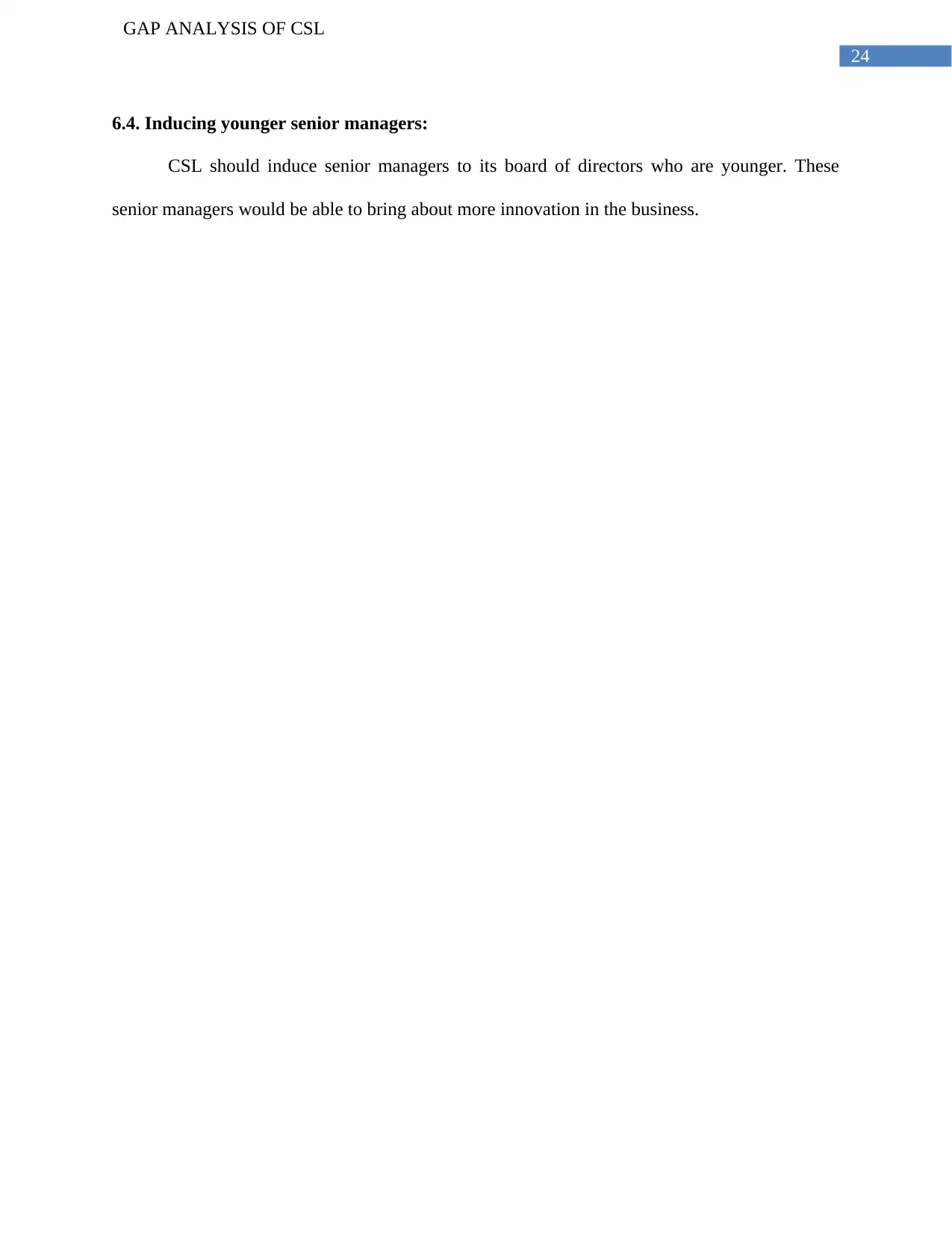
24
GAP ANALYSIS OF CSL
6.4. Inducing younger senior managers:
CSL should induce senior managers to its board of directors who are younger. These
senior managers would be able to bring about more innovation in the business.
GAP ANALYSIS OF CSL
6.4. Inducing younger senior managers:
CSL should induce senior managers to its board of directors who are younger. These
senior managers would be able to bring about more innovation in the business.
Paraphrase This Document
Need a fresh take? Get an instant paraphrase of this document with our AI Paraphraser
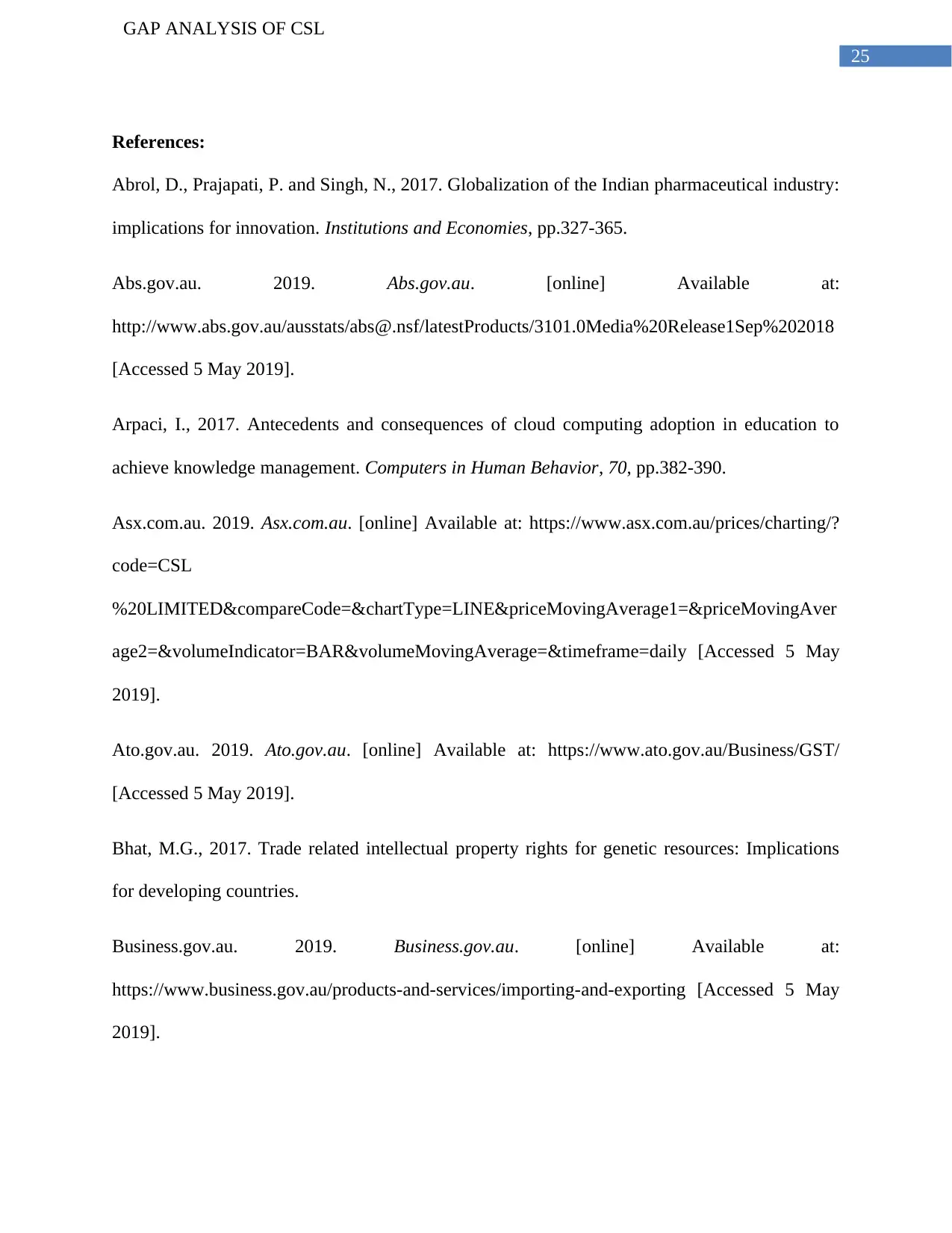
25
GAP ANALYSIS OF CSL
References:
Abrol, D., Prajapati, P. and Singh, N., 2017. Globalization of the Indian pharmaceutical industry:
implications for innovation. Institutions and Economies, pp.327-365.
Abs.gov.au. 2019. Abs.gov.au. [online] Available at:
http://www.abs.gov.au/ausstats/abs@.nsf/latestProducts/3101.0Media%20Release1Sep%202018
[Accessed 5 May 2019].
Arpaci, I., 2017. Antecedents and consequences of cloud computing adoption in education to
achieve knowledge management. Computers in Human Behavior, 70, pp.382-390.
Asx.com.au. 2019. Asx.com.au. [online] Available at: https://www.asx.com.au/prices/charting/?
code=CSL
%20LIMITED&compareCode=&chartType=LINE&priceMovingAverage1=&priceMovingAver
age2=&volumeIndicator=BAR&volumeMovingAverage=&timeframe=daily [Accessed 5 May
2019].
Ato.gov.au. 2019. Ato.gov.au. [online] Available at: https://www.ato.gov.au/Business/GST/
[Accessed 5 May 2019].
Bhat, M.G., 2017. Trade related intellectual property rights for genetic resources: Implications
for developing countries.
Business.gov.au. 2019. Business.gov.au. [online] Available at:
https://www.business.gov.au/products-and-services/importing-and-exporting [Accessed 5 May
2019].
GAP ANALYSIS OF CSL
References:
Abrol, D., Prajapati, P. and Singh, N., 2017. Globalization of the Indian pharmaceutical industry:
implications for innovation. Institutions and Economies, pp.327-365.
Abs.gov.au. 2019. Abs.gov.au. [online] Available at:
http://www.abs.gov.au/ausstats/abs@.nsf/latestProducts/3101.0Media%20Release1Sep%202018
[Accessed 5 May 2019].
Arpaci, I., 2017. Antecedents and consequences of cloud computing adoption in education to
achieve knowledge management. Computers in Human Behavior, 70, pp.382-390.
Asx.com.au. 2019. Asx.com.au. [online] Available at: https://www.asx.com.au/prices/charting/?
code=CSL
%20LIMITED&compareCode=&chartType=LINE&priceMovingAverage1=&priceMovingAver
age2=&volumeIndicator=BAR&volumeMovingAverage=&timeframe=daily [Accessed 5 May
2019].
Ato.gov.au. 2019. Ato.gov.au. [online] Available at: https://www.ato.gov.au/Business/GST/
[Accessed 5 May 2019].
Bhat, M.G., 2017. Trade related intellectual property rights for genetic resources: Implications
for developing countries.
Business.gov.au. 2019. Business.gov.au. [online] Available at:
https://www.business.gov.au/products-and-services/importing-and-exporting [Accessed 5 May
2019].
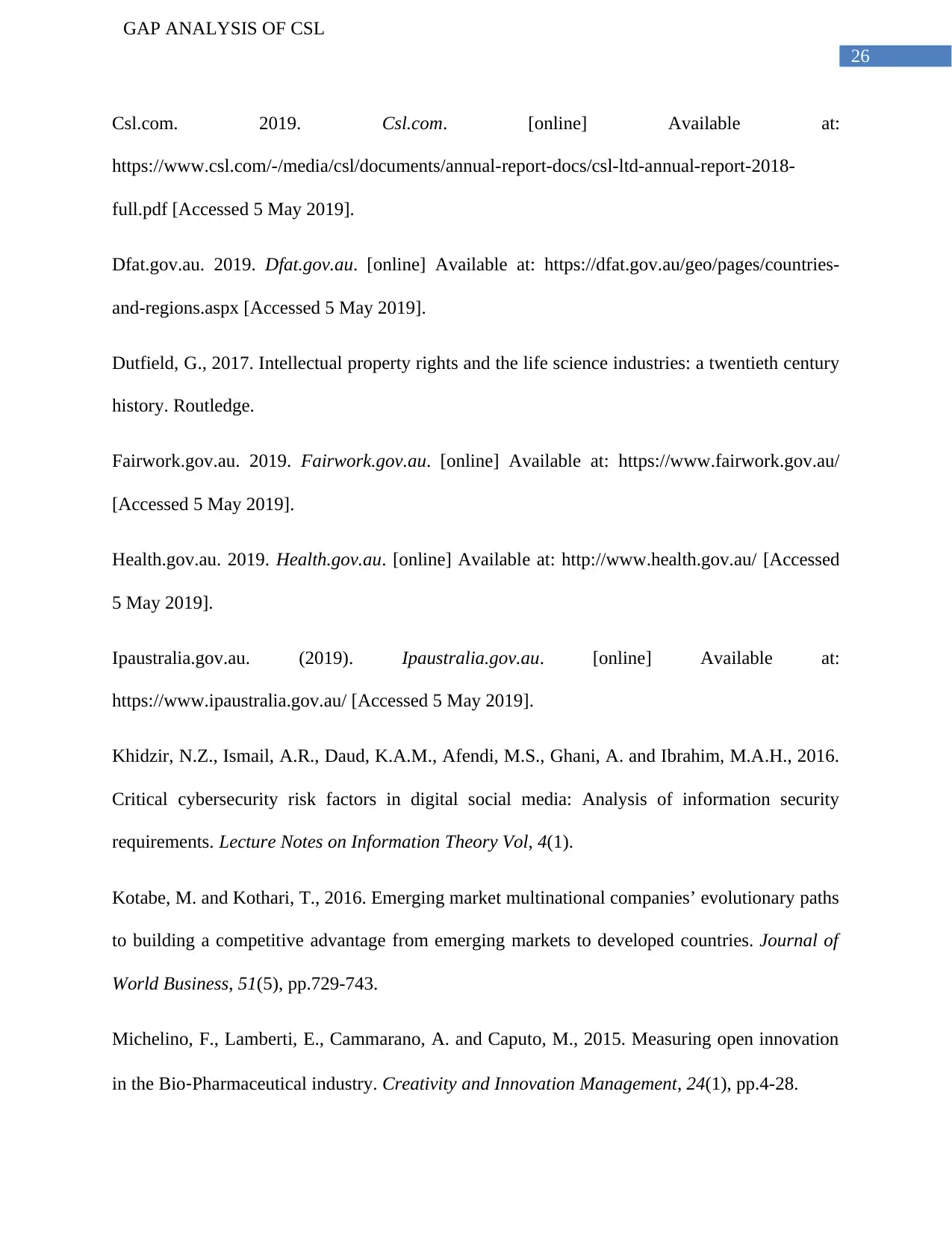
26
GAP ANALYSIS OF CSL
Csl.com. 2019. Csl.com. [online] Available at:
https://www.csl.com/-/media/csl/documents/annual-report-docs/csl-ltd-annual-report-2018-
full.pdf [Accessed 5 May 2019].
Dfat.gov.au. 2019. Dfat.gov.au. [online] Available at: https://dfat.gov.au/geo/pages/countries-
and-regions.aspx [Accessed 5 May 2019].
Dutfield, G., 2017. Intellectual property rights and the life science industries: a twentieth century
history. Routledge.
Fairwork.gov.au. 2019. Fairwork.gov.au. [online] Available at: https://www.fairwork.gov.au/
[Accessed 5 May 2019].
Health.gov.au. 2019. Health.gov.au. [online] Available at: http://www.health.gov.au/ [Accessed
5 May 2019].
Ipaustralia.gov.au. (2019). Ipaustralia.gov.au. [online] Available at:
https://www.ipaustralia.gov.au/ [Accessed 5 May 2019].
Khidzir, N.Z., Ismail, A.R., Daud, K.A.M., Afendi, M.S., Ghani, A. and Ibrahim, M.A.H., 2016.
Critical cybersecurity risk factors in digital social media: Analysis of information security
requirements. Lecture Notes on Information Theory Vol, 4(1).
Kotabe, M. and Kothari, T., 2016. Emerging market multinational companies’ evolutionary paths
to building a competitive advantage from emerging markets to developed countries. Journal of
World Business, 51(5), pp.729-743.
Michelino, F., Lamberti, E., Cammarano, A. and Caputo, M., 2015. Measuring open innovation
in the Bio‐Pharmaceutical industry. Creativity and Innovation Management, 24(1), pp.4-28.
GAP ANALYSIS OF CSL
Csl.com. 2019. Csl.com. [online] Available at:
https://www.csl.com/-/media/csl/documents/annual-report-docs/csl-ltd-annual-report-2018-
full.pdf [Accessed 5 May 2019].
Dfat.gov.au. 2019. Dfat.gov.au. [online] Available at: https://dfat.gov.au/geo/pages/countries-
and-regions.aspx [Accessed 5 May 2019].
Dutfield, G., 2017. Intellectual property rights and the life science industries: a twentieth century
history. Routledge.
Fairwork.gov.au. 2019. Fairwork.gov.au. [online] Available at: https://www.fairwork.gov.au/
[Accessed 5 May 2019].
Health.gov.au. 2019. Health.gov.au. [online] Available at: http://www.health.gov.au/ [Accessed
5 May 2019].
Ipaustralia.gov.au. (2019). Ipaustralia.gov.au. [online] Available at:
https://www.ipaustralia.gov.au/ [Accessed 5 May 2019].
Khidzir, N.Z., Ismail, A.R., Daud, K.A.M., Afendi, M.S., Ghani, A. and Ibrahim, M.A.H., 2016.
Critical cybersecurity risk factors in digital social media: Analysis of information security
requirements. Lecture Notes on Information Theory Vol, 4(1).
Kotabe, M. and Kothari, T., 2016. Emerging market multinational companies’ evolutionary paths
to building a competitive advantage from emerging markets to developed countries. Journal of
World Business, 51(5), pp.729-743.
Michelino, F., Lamberti, E., Cammarano, A. and Caputo, M., 2015. Measuring open innovation
in the Bio‐Pharmaceutical industry. Creativity and Innovation Management, 24(1), pp.4-28.
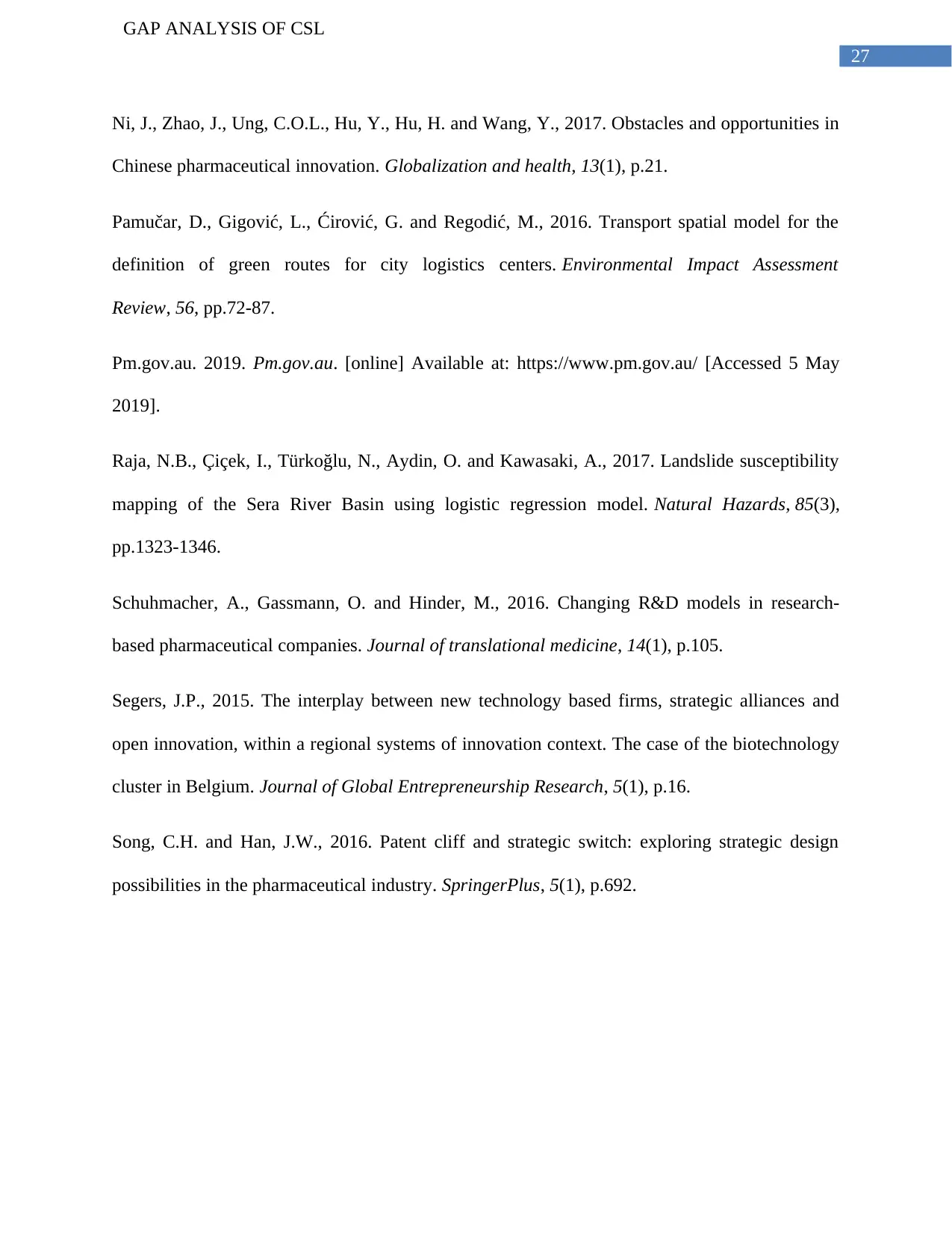
27
GAP ANALYSIS OF CSL
Ni, J., Zhao, J., Ung, C.O.L., Hu, Y., Hu, H. and Wang, Y., 2017. Obstacles and opportunities in
Chinese pharmaceutical innovation. Globalization and health, 13(1), p.21.
Pamučar, D., Gigović, L., Ćirović, G. and Regodić, M., 2016. Transport spatial model for the
definition of green routes for city logistics centers. Environmental Impact Assessment
Review, 56, pp.72-87.
Pm.gov.au. 2019. Pm.gov.au. [online] Available at: https://www.pm.gov.au/ [Accessed 5 May
2019].
Raja, N.B., Çiçek, I., Türkoğlu, N., Aydin, O. and Kawasaki, A., 2017. Landslide susceptibility
mapping of the Sera River Basin using logistic regression model. Natural Hazards, 85(3),
pp.1323-1346.
Schuhmacher, A., Gassmann, O. and Hinder, M., 2016. Changing R&D models in research-
based pharmaceutical companies. Journal of translational medicine, 14(1), p.105.
Segers, J.P., 2015. The interplay between new technology based firms, strategic alliances and
open innovation, within a regional systems of innovation context. The case of the biotechnology
cluster in Belgium. Journal of Global Entrepreneurship Research, 5(1), p.16.
Song, C.H. and Han, J.W., 2016. Patent cliff and strategic switch: exploring strategic design
possibilities in the pharmaceutical industry. SpringerPlus, 5(1), p.692.
GAP ANALYSIS OF CSL
Ni, J., Zhao, J., Ung, C.O.L., Hu, Y., Hu, H. and Wang, Y., 2017. Obstacles and opportunities in
Chinese pharmaceutical innovation. Globalization and health, 13(1), p.21.
Pamučar, D., Gigović, L., Ćirović, G. and Regodić, M., 2016. Transport spatial model for the
definition of green routes for city logistics centers. Environmental Impact Assessment
Review, 56, pp.72-87.
Pm.gov.au. 2019. Pm.gov.au. [online] Available at: https://www.pm.gov.au/ [Accessed 5 May
2019].
Raja, N.B., Çiçek, I., Türkoğlu, N., Aydin, O. and Kawasaki, A., 2017. Landslide susceptibility
mapping of the Sera River Basin using logistic regression model. Natural Hazards, 85(3),
pp.1323-1346.
Schuhmacher, A., Gassmann, O. and Hinder, M., 2016. Changing R&D models in research-
based pharmaceutical companies. Journal of translational medicine, 14(1), p.105.
Segers, J.P., 2015. The interplay between new technology based firms, strategic alliances and
open innovation, within a regional systems of innovation context. The case of the biotechnology
cluster in Belgium. Journal of Global Entrepreneurship Research, 5(1), p.16.
Song, C.H. and Han, J.W., 2016. Patent cliff and strategic switch: exploring strategic design
possibilities in the pharmaceutical industry. SpringerPlus, 5(1), p.692.
1 out of 28
Related Documents
Your All-in-One AI-Powered Toolkit for Academic Success.
+13062052269
info@desklib.com
Available 24*7 on WhatsApp / Email
![[object Object]](/_next/static/media/star-bottom.7253800d.svg)
Unlock your academic potential
© 2024 | Zucol Services PVT LTD | All rights reserved.





